





With a name inspired by the Monarch butterflies that call our Legacy Gardens home, Monarch Pavilion is the beautiful new four-floor neighborhood for all of Canterbury Court’s healthcare services. Featuring Assisted Living and Memory Support as well as Skilled Nursing, residents of all faiths receive the healthcare they need with the warm, person-centered approach Canterbury Court is known for.


To learn more and to schedule a personal tour, contact us today at (404) 201-6988, visit canterburycourt.org/expertcare, or scan the QR code.
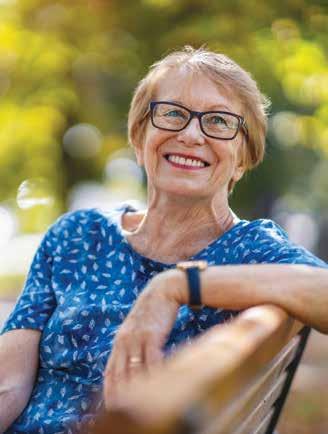













T r y S u n d a y s a t C B H C o m m u n i t y S c h o o l i f y o u w a n t a r e l i g i o u s s c h o o l e x p e r i e n c e t h a t
( F i l l i n t h e b l a n k : )
□ W a r m l y w e l c o m e s y o u t o m a k e f r i e n d s i n a c o z y s e t t i n g w h e r e y o u ’ l l n e v e r g e t l o s t i n t h e c r o w d
□ F o s t e r s l o n g - l a s t i n g J e w i s h f r i e n d s h i p s f o r o u r k i d s ( a n d m a y b e e v e n s o m e f r i e n d s t o g o t o c a m p w i t h n e x t y e a r ? ! )
□ B u i l d s s t u d e n t s ’ c o n n e c t i o n w i t h t h e i r f u t u r e B M i t z v a h c o h o r t s
W h a t W e O f f e r :
H e b r e w : L e a r n t o r e a d & r e c i t e J e w i s h p r a y e r s
J u d a i c s : V a l u e s - b a s e d a n d e x p e r i e n t i a l
H a v e r i m C l u b s : A f r i e n d s h i p - b u i l d i n g J e w i s h a p p r o a c h t o p a s s i o n s l i k e a r t , n a t u r e , s p o r t s e v e n M i n e c r a f t !
H i s t o r y & I d e n t i t y : P r i d e i n t h e d i v e r s i t y o f t h e J e w i s h p e o p l e , e s p e c i a l l y i n c e l e b r a t i n g t h e L G B T Q + c o m m u n i t y
Considering but not 100% sure? Reach out to the CBH Education Director to set up a free visit on our first day of school: education@cbhatlanta.org


Already sold? Register for August using the QR code!

PUBLISHER
MICHAEL A. MORRIS michael@atljewishtimes.com
MANAGING PUBLISHER & EDITOR
KAYLENE LADINSKY
kaylene@atljewishtimes.com
EDITORIAL
Associate Editor & Website Editor
SASHA HELLER sasha@atljewishtimes.com

Staff Writer & Proofreader
FRAN PUTNEY fran@atljewishtimes.com
CONTRIBUTORS THIS ISSUE
ALLEN H. LIPIS BOB BAHR
CHANA SHAPIRO
DAVE SCHECHTER DAVID OSTROWSKY DEBBIE DIAMOND
JAN JABEN-EILON JD KREBS
MARCIA CALLER JAFFE
ADVERTISING
Senior Account Manager & Team Supervisor
MICHAL BONELL michal@atljewishtimes.com
Account Manager
ILYSSA KLEIN
ilyssa@atljewishtimes.com

Account Manager
ELIZABETH LANGFELDER elizabeth@atljewishtimes.com

CREATIVE & DESIGN
Creative Director LILLI JENNISON lilli@atljewishtimes.com
COMMUNITY ENGAGEMENT
Events and Public Relations Coordinator KATIE GAFFIN katie@atljewishtimes.com
Atlanta Jewish Connector Coordinator DIANA COLE
Diana@atljewishtimes.com
GENERAL OFFICE
Administrative Assistant REBECCA LABANCA info@atljewishtimes.com

The Atlanta Jewish Times once again won Best Website at the American Jewish Press Association conference as part of the 42nd annual Simon Rockower Awards ceremony held July 11 at the National World War II Museum in New Orleans.
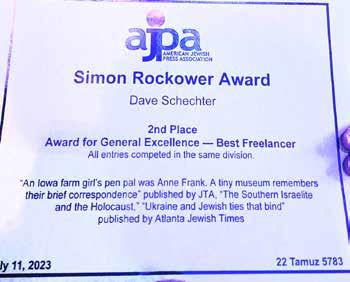



According to the judges’ report: “The Atlanta Jewish Times has a polished, modern website. It is easy to navigate and follows many principles of good web design. Its social media, newsletter, and subscription links are displayed at the top, as they should be. Its latest news section includes timestamps, which is important for showing that the site is fresh. The events section includes two types of formats to attract reader interest.”
As the judging period took place shortly after Passover, the version of the website that was judged included the AJT’s popular annual community and staff Passover messages. As such, the judges also commented on how the section of Passover messages from community members “helps connect readers to familiar faces and names.”
It’s relevant to note that most of the award categories included divisions based on the publications’ subscription totals, so that publications of relatively equal size can squarely compete against one another. However, the Best Website category included no divisions, as all eligible AJPA publications competed against one another, with the AJT’s website taking first place.
Associate editor Sasha Heller said, “We challenged ourselves last year to take an already great website and make it better. Now, the challenge is to repeat.”
Heller continued, “Having a viable website in today’s industry is essential for any publication. And it’s one of the reasons the AJT is successful…the website is just one part of our media footprint, along with our print editions, AJT Connector, Jewish Time podcasts, newsletters, and social media presence.”
Heller added that he feels the AJT’s site is popular because its sleek, modular design is tailored for mobile devices, but the user interface also works well on desktop computers. “It’s the best of both worlds and that’s important because roughly half of our website traffic comes from smartphones and tablets and half from desktop systems.”
AJT freelancers Jan Jaben-Eilon and Dave Schechter also won personal awards for their local reporting and edi-
torial selections.
Jaben-Eilon won second place for
The Boris Smolar Award for Excellence in Enterprise or Investigative Reporting (Division A: Weekly and Biweekly Newspapers) for her series of articles covering local antisemitic acts and Holocaust education, including:
• Incident at Cobb School Horrifies Jewish Community
• East Side Elementary’s New Logo
Disturbs Community
• Cobb Middle School Students Get
Holocaust Lesson
“It is always nice to be recognized for the hard work we do on stories we care about,” said Jaben-Eilon.
Schechter won second place for Best Freelancer, with no specification for division, as all AJPA freelancers competed together in the same category. Schechter won his award for the following three ar-
ticles:
• An Iowa farm girl’s pen pal was Anne Frank. A tiny museum remembers their brief correspondence – published by Jewish Telegraphic Agency
• The Southern Israelite and the Holocaust
• Ukraine and Jewish Ties That Bind
The judges included comments for Schechter’s selections, noting: “Impressive range, from Iowa farm fields
to Ukraine and the depths of his own paper’s archives, each story has a lovely narrative flow but with purpose and empathy.”
Additionally, Schechter’s article on Anne Frank’s pen pal also received second place for the category of North American Jewish History.
Schechter said, “Recognition by the American Jewish Press Association, through its Rockower Awards, is appreciated. My thanks to the Atlanta Jewish Times and the Jewish Telegraphic Agency for publishing the articles that were hon-


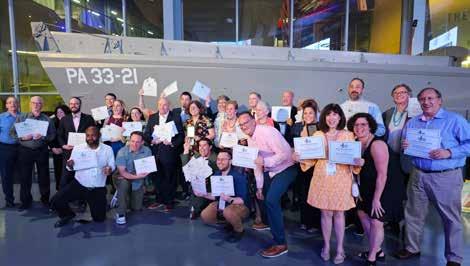

ored.”
“Atlanta Jewish Times was named ‘Best Newspaper’ and now we get to add ‘Best Website’ to our first-place awards from the American Jewish Press Association because we work hard,” said Kaylene Ladinsky, AJT’s editor and managing publisher. “We love our community and want to serve up the very best to our readers and visitors with everything we publish. I couldn’t be prouder of our staff and freelance team that makes it happen every day. They are the best, so it’s only natural that the AJT is ‘best’, too.” ì
Traveling more than 5,000 miles to reach Krakow, Poland, a group of 11 Jewish Atlantans participated in the city’s annual Ride for the Living, a four-day event that enables participants to immerse themselves in Krakow’s Jewish past, present and future while raising money to support the resurgence of Jewish life in Poland. The event is sponsored by the JCC Krakow.
The Atlanta group of cyclists was assembled by Marcia and Mark Miller. Marcia Miller had been to Poland a few times, including a five-day tour in February 2020, and she had dreamed of returning soon afterward. The pandemic hit and her plans were delayed; but return she did – and this time with a group of 10 friends accompanying her.
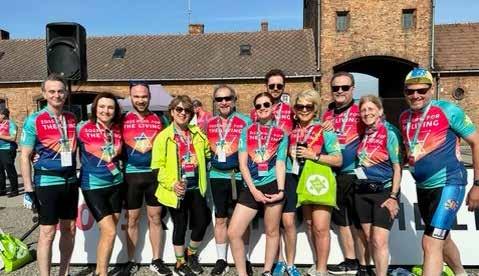
Attending this summer’s RFTL with the Millers were Eric Robbins, CEO of the Jewish Federation of Greater Atlanta, and his daughter, Sasha; Cherie and Gary Aviv; Deborah and Lou Jacobs; Shelley and Bruce Gaynes; and Ryan Kaplan, who had worked at the JCC Krakow as the director of RFTL. Trekking 60 miles – from the gates of Auschwitz-Birkenau to the JCC Krakow – the group was touched immensely by the experience.
“We saw the four-day event -- the bike ride and all the activities associated with it -- as an opportunity for us as Jewish people to help others when the world largely did not help us. I have a hard time understanding the evil that causes people to do what they did. I ask myself how we stop the genocide that keeps happening to different people at different times,” said Miller.
Certainly, the group was moved by the large numbers of Ukrainian refugees in Krakow that were being helped by the Krakow JCC. “I went into a room at the JCC filled with food, baby strollers and clothes. I saw the refugees being helped by the efforts of the JCC and the Krakow community. The fallout from the war was literally in front of us as we encountered the Ukrainian people who had arrived in Poland with almost nothing and yet were being aided by this community, regardless of their religion,” said Cherie Aviv.
The four-day event began with a trip to Auschwitz and Auschwitz-Birkenau, where the group had a private tour and said Kaddish. Prior to World War II, there were 70,000 Jewish people in Krakow. Today, the Jewish community numbers about 2,000.
“Jewish life in Poland did not end in Auschwitz. There are Jewish people who
hid their identities during Communism and are now part of our vibrant community. There are many younger people, in fact, who have found out they are Jewish and now embrace their Jewishness wholeheartedly,” said Jonathan Ornstein, CEO of the JCC Krakow.
The Friday bike ride, with about 200 cyclists participating, was led by two Holocaust survivors, Marcel Zielinski, 88, and
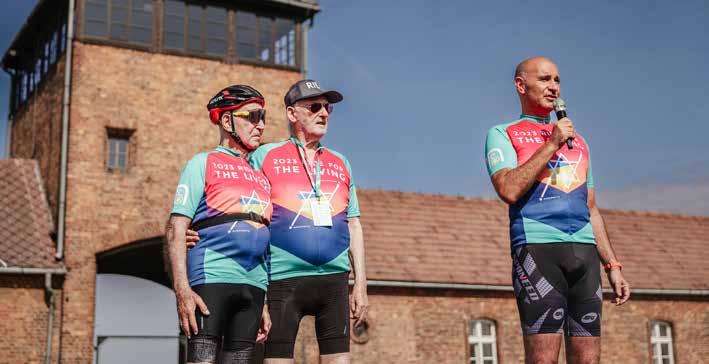
Bernard Offen, 94. The ride retraces the route taken by Zielinski, then 10 years old, when he was liberated from Auschwitz in 1945. Later that night, a festive and memorable Shabbat dinner was held in conjunction with the Jewish Culture Festival and attended by 700 people, including the cyclists, survivors, volunteers, and members of the Krakow community.
On Saturday, the group took part in
educational experiences, lectures, and tours to learn about Jewish life in Krakow before and during the war. That evening, attendees participated in a Havdalah ceremony, and many attended an open-air concert featuring headlining acts from the Jewish Culture Festival, which was happening concurrently in Krakow. There was also a pre-screening of the feature documentary, “For the Living.”
On Sunday, the official opening of the Senior Club Kitchen was held at the JCC Krakow. Funded by the Marcia and Mark Miller Family Foundation, Ornstein spoke about the ongoing involvement and generosity the Millers have shown for the Krakow survivor community. “The Senior Club is the heart of our community, and the kitchen is where it all happens. It’s the

place people go to share meals and stories. The survivors bring their children and grandchildren. This gift is already transforming their lives,” emphasized Ornstein.
Robbins is especially interested in the work being done in Krakow and pointed out the long history of the Jews in Poland. He and his daughter, Sasha, were especially moved by the experience with RFTL.


Robbins would like to gather a group of Atlantans to head back to Krakow for a future ride. In late January 2024, Robbins will return to Poland and Israel with many of Atlanta’s senior rabbis and leaders of Jewish organizations under the auspices of the Jewish Community Relations Council of Atlanta and the Jewish Federation.
Following the trip’s conclusion, Che-
rie Aviv told the story of carefully unwrapping a cherished memento she had brought back to Atlanta from her trip. During her visit, she visited the Krakow Jewish Museum and purchased a necklace she will treasure forever. Though simple, the Jewish star will forever be a reminder of Krakow – its past, present, and future. ì
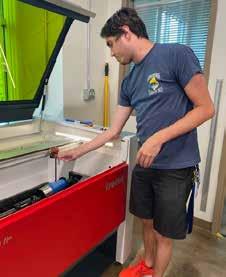
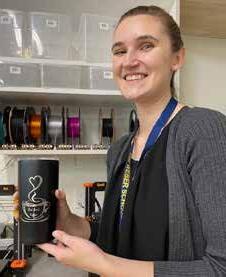
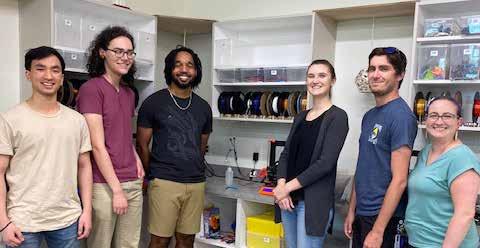 By Debbie Diamond
By Debbie Diamond
For two weeks this summer, The Daniel Zalik Academy of Science, Technology, Engineering, and Design at The Weber School opened its doors to the larger Atlanta community and invited visitors to take part in a myriad of courses developed to inspire, engage, and develop would-be scientists, creators, and designers.
The Fab Lab, as the space is known to students and faculty at The Weber School, became a place where participants could discover new skills or work on existing projects in the areas of science, technology, and design. Under the direction of DZA teachers and student lab assistants, participants immersed themselves in a variety of courses, including introductory classes for laser cutting, vinyl cutting and 3D printing. In addition, visitors were able to work on new or existing projects and schedule one-on-one time with lab instructors and student assistants for guidance on app development, robotics, product design and development and applied engineering. And at the end of each day, visitors left with the tangible results of their efforts, which included earrings, engraved mugs, 3-D statues, 3-D brain teaser puzzles and laser-cut coffee cups.
Jake Malever, an incoming freshman from Alpharetta, was excited to take part in all the activities offered by DZA this summer. “I am hoping to take courses at DZA during the school year,” he said. Malever and his father, Jerred Malever, had attended two consecutive days and created a 3-D Spiderman statue and a laserengraved cup.
“We wanted to create an event where people could learn, create, and collaborate in the atmosphere of an open lab. Our goal was to welcome all levels of learners and encourage people to get their feet wet with this type of experience,” said Madi Anderson, the director of educational operations and community partnerships for DZA.
The summer program came together very quickly in just one month, with all the instructors pulling together to make the experience a memorable one for all who participated. Led by Anderson, the other DZA instructors included Chris Chapman, director of technology and design; Alex McIntyre, assistant lab manager; Cathey Chapman, assistant lab manager; and lab assistants, Aviv Newman, who graduated with a DZA diploma
in 2023 and is headed to University of Georgia to major in computer science; Andrew Mulia, a recent Georgia Tech graduate; and Marie Chapman.
Anderson, who had been an instructor at The Weber School lab when DZA began, worked two years in the aerospace industry before coming back to lead DZA this year. One of her goals is to make the community better understand what DZA and the Fab Lab does and how the courses are applicable to their lives.

“Human-centered design principles impact everyone. By opening our space, people can think about what they would
like to create, and we can help them understand the technology to make it happen. We want our participants to feel comfortable and excited about the space and all it offers,” Anderson added.
The Daniel Zalik Academy opened five years ago, due to a generous donation by the Zalik Family Foundation. Since its inception, the center has served as a hub of creativity and collaboration, providing specialized programming and a platform for student leadership in a Massachusetts Institute of Technology-inspired and fully outfitted Fab Lab. The space is filled with state-of-the-art equipment
and new machinery typically found only in universities and corporate labs.
According to Head of School Rabbi Ed Harwitz, “The ‘secret sauce’ at the root of the DZA is the dynamic leadership, professional expertise and student-centered instruction provided by its missiondriven faculty and staff.” Rabbi Harwitz foresees Weber students and alumni emerging as the next generation of scientists, technology experts and design specialists committed to the Jewish values of tzedakah (righteous action) and guided by Jewish social consciousness.
During the school year, the school
reports that 80 percent of enrolled students will experience DZA either through a designated class in the lab or via an interdisciplinary course. In addition, 25 percent of Weber students will receive a prestigious DZA diploma upon graduation, which is earned by taking two classes in the program as well as the Capstone class.

One of the popular interdisciplinary offerings at Weber is “Torah, Toolkits and Power Tools,” a class that incorporates Jewish studies with activities that take place in the DZA, led by McIntyre. The students in the class produce unique pieces of art inspired by Torah and Judaic texts they study. For example, beautiful challah cutting boards that reflect personally meaningful words were created by students in the class last year.
Each student who participated designed their own board and cut, sized, and worked with their wood using a miter saw, jointer, table saw, and planer in order to create strips of squared, smooth wood that were ready to be glued together. Following this step, the wood boards were cleaned, sanded, oiled, and varnished. Each student selected a word that represented what was meaningful to them based on what they had learned and used the laser cutter to etch the word on the board.
“Part of our job is to help the teens realize that STEM is not just sitting in a dark room coding or in a lab with beakers. We want to make what we are doing relatable to their lives and everyday interests,” said Chris Chapman.
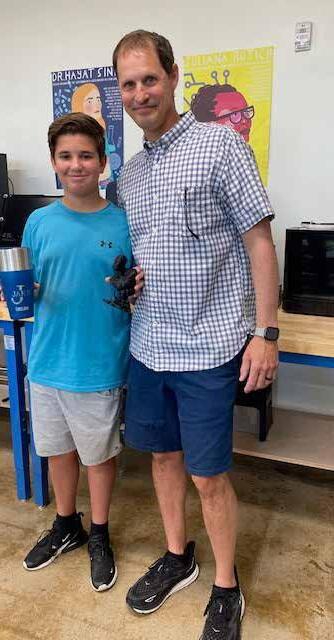

Rabbi Harwitz pointed to Anderson, the DZA instructors and the student lab mentors for bringing the distinct, creative program and culture beyond the walls of The Weber School and into the larger community this summer.
Harwitz indicated plans to offer participation opportunities to the broader community in the future at the high school. The Weber School will introduce many new centers of excellence in 2023 and beyond, including a performance center and athletic complex.
“The DZA Open Lab is the latest in a series of initiatives to advance Weber’s broad mission as a 21st century Jewish community high school, where our distinguished faculty and staff, guiding highly committed and talented students, share ‘Only at Weber’ experiences with teenagers and families across Jewish Atlanta and throughout our broader community,” emphasized Harwitz.
For additional information about The Daniel Zalik Academy, please visit www.weberschool.org/academics/thedaniel-zalik-academy.


The recent Supreme Court decision that struck down affirmative action in admissions programs in higher education was generally criticized by national Jewish organizations that have taken an interest in the case.

The Anti-Defamation League three years ago filed a brief in federal appeals court supporting Harvard University’s decision to make race an issue in admissions. It argued at the time that Harvard had a compelling interest in having a racially diverse student body and that race was just one factor among many that the university used.
When the 6-3 decision was announced on June 29, the ADL’s chief counsel Steve Freeman was quick to express what he indicated was the organization’s “deep disappointment.”

“This decision,” Freeman said, “reflects a fundamental misunderstanding of the history and present realities of racial discrimination in this country and the reasons why affirmative action is still needed.”
The National Council of Jewish Women, which had also filed a brief in the case which supported affirmative action, was equally dissatisfied. The chief policy officer of the organization, Jody Rabhan, calls affirmative action a “criti-

cal tool” for gaining racial equality.
“The decisions in these cases are a disturbing step backward on the road to true racial equality and equity — the guiding star NCJW advocates will continue to fight for in state houses and in
Congress.”
In Atlanta, Sherry Frank, who serves as co-president of the local NCJW chapter, saw the decision as part of a wider pattern of what she felt were troubling developments.
“I think racial justice has been set back in a lot of fronts, but particularly damaging in education. I mean, when you see the kind of ban on books, when you see the curtailing of discussion of our true history, you know, the impact is pretty devastating, and it affects all of us.”
Frank, who was instrumental in the founding of Atlanta’s Black Jewish Coalition, has worked for years to improve the relationship between the Jewish community and African Americans. In the last several decades of the 20th century, affirmative action was seen as a bedrock issue in the minority community. In the African American community of the 1970s and 1980s, the issue was as important to many Black political leaders as support for Israel was for prominent Jews.
When she was the American Jewish Committee representative in Atlanta, Frank became keenly aware of how important the issue was for both communities.

“Many Jews, particularly more progressive Jews, understood the importance of making the playing field more equal and moved towards supporting affirmative action. I can tell you when I was at the American Jewish Committee, and I would get a call from Andrew Young or Maynard Jackson to speak out on affirmative action, I did.”
However, Rabbi Shalom Lewis, the Rabbi Emeritus of Congregation Etz Chaim, the conservative synagogue in East Cobb, sees the Supreme Court decision as correct. Affirmative action, he believes, is a program of the past.
“I think there will be those that will claim that it is a return to bigotry. I don’t
see it that way. What the Supreme Court did was a reassertion that people of color have made great strides in this country, from the presidency to mayors to personalities in business to the police departments, even. America today is not the America of years ago when affirmative action perhaps served a purpose.”
Prominent Jewish organizations, too, have not always been supporters of affirmative action. Fifty years ago, Allan Bakke, a NASA engineer, was twice rejected by the University of California Medical School over a quota program that reserved 16 percent of the incoming class for disadvantaged minorities. He sued.
The case went to the Supreme Court and the three major Jewish organizations at the time, the ADL, the American Jewish Congress, and the American Jewish Committee, all filed briefs in support of Bakke. He won.
Reform Judaism was also opposed to a numbers system. In 1977, the URJ passed a resolution stating that equal opportunity was “morally obligatory.” But it rejected quotas in favor of such tools as goals and timetables.
In response to last month’s Supreme Court decision, Rabbi Brad Levenberg at Temple Sinai, a Reform synagogue in Sandy Springs, maintained some of the ambivalence that the Reform movement expressed so many years ago.

“Our communities still are far from equitable,” Rabbi Levenberg commented, “and racial divides remain remarkably problematic when considered through the lens of opportunity. While affirmative action was never ideal, it was a better solution than doing nothing.” ì
In this highly competitive market, our extensive network of highly influential buyers and sellers and marketing prowess distinguish us from the competition. With a focus on exceptional service, The Schiff Team proudly represents a diverse range of property types across various price points. For an extraordinary outcome akin to our proven track record, reach out to us today and unlock a world of opportunities.







 By Jan Jaben-Eilon
By Jan Jaben-Eilon
Brooklynite Elan Kornblum, who is known in the observant Jewish world for his Great Kosher Restaurant Foodies Facebook website, said he has long been able to obtain kosher meals on airflights and, in the last few years, on cruises, especially during Passover, but these were always “packaged, warmed up” meals. Only in the last couple of years have kosher fresh meals been available on one major cruise line, and last August he took his family on a Royal Caribbean cruise to Alaska to take a close-up look at the new offerings.
“This is a game changer,” Kornblum told the AJT. “The buffet was much better quality. It wasn’t in tin foil. I felt like a mensch.”
Atlanta families are now set to take their close-up view and stomachs on Royal Caribbean’s Quantum of the Seas cruise to Alaska in August. Of the approximately 3,000 passengers on this cruise, 300 have opted for the special kosher alternative, enabled by a kitchen certified kosher by Rabbi Dovid Weberman, who has been certifying kosher cuisine since 1997.
According to Weberman, all kosher team members (mashgichim and mashgichot) are Orthodox observant. All kosher meals are produced under mashgiach temidi. Dairy products are cholov stam
Two of those Atlanta families are David and Eve Adler, and good friends, Jeff and Diane Blank, the latter of whom will be joined by her parents from New York and a daughter, son-in-law and child coming from Israel for the Alaskan cruise.
The Blanks have taken four cruises previously, but always had packaged meals. “They all taste the same and are microwaved,” she said. “The kosher element enhances the trip.” She noted that she had read Kornblum’s description of his kosher experience on an Alaskan cruise last year, giving her the idea.
The Adlers have experienced allkosher river cruises, but she heard that the Royal Caribbean kosher option is “like going to a wedding every night,” the food is so good. She heard the breakfasts are as extensive as hotel breakfasts in Israel. This will be the Adlers’ first Alaskan cruise and first cruise aboard Royal Caribbean.
The cruise line is offering what it called “Kosher Fresh Dining” packages on three sailings this August, two to Alaska from Seattle and one sailing to
the Bahamas from New Jersey. The cruise line’s media department said that with the “purchase of the package, guests will have access to fresh kosher meals served buffet style in the Solarium Bistro during breakfast, lunch, and dinner. Sit-down dinner with three times [will be] available for Shabbat. Glatt Kosher supervision [is] by Rabbi Dovid Weberman.”
According to Kornblum, Royal Caribbean sets aside one kitchen that is cleaned, sanitized, and koshered with specially trained chefs and one dining room set aside for the kosher-requiring

passengers who pay $60 per person per day for the kosher-certified food. Children ages six to 12 pay $30 per person per day. Children under five are free.
In addition, states Weberman, kosher red and white wine is available for purchase by the bottle. Special signage is posted to direct those paying for the kosher option to the correct dining room.
While a rabbi is on board to provide kosher supervision, said Weberman, the Royal Caribbean culinary team onboard will have a dedicated group trained in kosher operations to prepare all kosher
food for the sailing. “All food is sourced from reputable and long-term suppliers of Royal Caribbean. All meat and poultry are kosher. The kosher support team will assist in answering questions from our guests on how the food preparation is supervised,” he said.
Floridian Sharon Leeds has been a travel agent for 35 years but now focuses solely on kosher cruises. “There’s a large demand,” pointing to the Royal Caribbean’s kosher-option cruises in Alaska and the Caribbean. The latter are timed in January when yeshivot have vacation
times. “Last year, there were four cruises during yeshiva week. We sell to a lot of kosher clients who are first-time cruisers.”
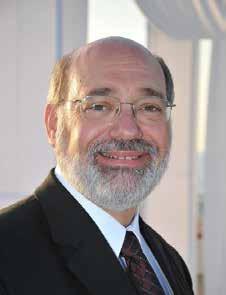
Leeds noted that kosher meals can be found on any cruise line, but it is packaged food brought to the ships. “We focus on Royal Caribbean. It’s unique because all food is prepared and organized
through the cruise line,” which, she added, is organizing a charter cruise in May.
Also on board, Leeds organizes a conference room for prayer services.

The majority of Leeds’ clients come from the Northeast U.S., but there are always some from Georgia, she said. “This is so new. I hope other cruise lines will add this option,” Leeds said.
Kornblum said he has heard talk of other cruise lines getting into the fresh kosher food experience. The Royal Caribbean kosher option, which he noted is also available on cruises from Haifa to Greece, always “sells out within a few weeks.”

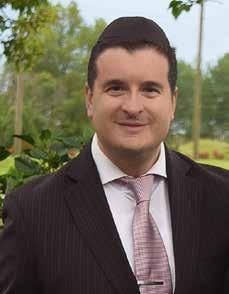
He enjoyed his Alaskan cruise so much last year that he decided to join the
Royal Caribbean cruise to the Caribbean at the end of August.
In addition to the attraction of getting on-board prepared kosher-certified food on her upcoming Alaskan cruise, Diane Blank spoke of another benefit of cruises. “It’s hard to bring the family together. Cruising is a great way to bring together different generations.” ì
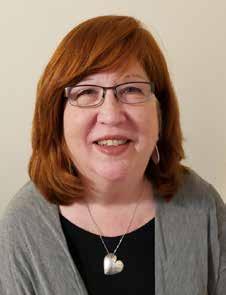
Did you do a double take when you saw a two-tone, green 1947 Pontiac with whitewall tires in a parking lot? How about spotting a spunky, yellow 1951 Studebaker coupe cruising merrily down the road?
Alan Ziglin, an energetic and affable retiree with the nickname, “Dr. Z,” (PhD) is the owner of those two collector cars and five others, including a 1929 Studebaker, two convertibles -- a sleek 1959 Pontiac Bonneville (that looks like it might have once carried a movie star) and a 1967 Pontiac Grand Prix --a 1972 “boat-tail” Buick Riviera; and a 1969 Pontiac Grand Prix with a six-foot long hood (designed to be longer than the hood of a luxury Lincoln Continental).

Ziglin notes, “All of my cars are more than drivable. They are reliable. If I can’t drive them, I can’t enjoy them.” His a propos motto is, “Dr. Z’s Fleet That Can’t Be Beat.”
Ziglin and his wife, Rochelle, who enjoys accompanying him on collector trips and shows, have given each of their cars a pet name, reflecting a significant aspect of each one. The 1929 Studebaker is named “Stu” (obvious); the 1947 Pontiac is “Myrtle” (purchased in Myrtle Beach); the 1951 Studebaker is “Bullet” (front protrusion); the 1959 Pontiac is “Bonnie” (Bonneville); the 1967 Pontiac is “Granny” (Grand Prix); the 1969 Pontiac is “Jay” (a Model “J”); and the 1972 Buick is “Duncan” (previously owned in Duncan, Okla.). When Ziglin relates fascinating anecdotes about each of them, he sometimes refers to them by name.
One story involves the purchase of Bullet, the 1951 Studebaker. The original owner put a clove of garlic in the glove box for good luck. Its second owner, who bought the car when he was in high school, kept it there, and it was subsequently found in situ by Ziglin. Ziglin had the amazingly unspoiled clove encased in a small plastic display box, which he showed this reporter and visitor Howard Newman, another car enthusiast. Years later, the owner, from whom Ziglin bought the vehicle, came to Atlanta to show Bullet to his son, and they went for a ride in his old car.
A favorite anecdote took place in 1979, when Ziglin’s four-year-old son advised him not to buy a desired 1967 Pontiac Grand Prix convertible because the air conditioning louvres were broken. Thirty years later, the same model, with operable air duct louvres, was found. His

son approved, and Granny is now part of the fleet.
Whereas Ziglin’s cars would certainly fall into the often-used category of classic because of their ages, he demurs, preferring to group them together as “collector cars,” and he is philosophical about his ownership. He sees himself as the cars’ caretaker. He explains, “If I do my job correctly, the cars should last beyond me.”
All seven of his cars are totally reliable on the road. Ziglin notes, “I drive my cars all the time. Sometimes, I’ll run errands in one of them and then come home and switch to another one.” When asked if he is able to maintain his cars himself, he says he knows a lot about
them, yet he has a mechanic who appreciates his cars and services them with expertise.
The first collector car he bought, while he was still in grad school, is the 1929 Studebaker. It is rare: completely original—even the seat upholstery—and still bears its 94-year-old faded factory paint, orange pin striping, and wooden floor. There’s another way to evaluate rarity: that is, how many of a certain model were produced in a specific year.

Ziglin searched for 30 years to find a 1967 Grand Prix in the condition he sought, because General Motors manufactured fewer than 6,000 Grand Prix Pontiac convertibles… ever. That was the only year it was made: it, too, is rare.
In addition to the remarkable condition of the collection, the interiors and details of the cars are part of their allure. The 1947 Pontiac’s dashboard, with a clock centered on the glove box door, steering wheel-concentric horn, and Bakelite finials and knobs, is a perfect example of mid-century design, as is its avocado color. The “look at me” upholstery and glittery floor covering of the 1959 Pontiac convertible demand as much attention as its tail fins. The 1972 Buick features a “boat tail” as its distinguishing characteristic. The 1929 Studebaker’s running boards and external folding luggage rack (there is no trunk) are only two of its notable features.
Ziglin’s car enthusiasm extends be-
yond his fleet. He greets visitors sporting a car-themed shirt; the windows of the garages where his cars are parked are covered with car-patterned curtains, a long wall of a garage artistically displays dozens of spare hub caps, and another long wall holds scores of meaningful license plates, all from before the year
2000.
Ziglin remains an active collector, looking for cars he would love to own. His expertise is evidenced in his many published articles in club newsletters and magazines. The award-winning monthly, “Smoke Signals,” featured all his current Pontiacs (and one he sold) in separate

cover stories. Another award-winning magazine, “Turning Wheels,” highlighted his Studebakers in two cover stories.
The Ziglins, members of Congregation B’nai Torah, have two sons and two grandchildren, and his sons and daughter-in-law have all driven his cars. Ziglin willingly gives others memorable mo-



ments with his collection. He says, “We attract a lot of attention when we’re out and about in our collector cars. A lot of thumbs-up, a lot of pictures being taken, and a lot of questions which I enjoy answering.”
Who wouldn’t want a selfie with a 1929 Studebaker? ì
The new Dean of the College of Arts and Sciences at Emory University is Barbara Krauthamer whose father was a Holocaust survivor who came to America in the late 1930s. In that respect, she shares the family legacy of Emory’s president, Gregory Fenves, whose father was also a survivor of the Holocaust. Krauthamer’s mother is African American.
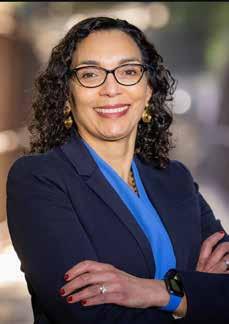
The new Emory Dean was previously Dean at the University of Massachusetts in Amherst. She’s a recognized scholar of African American history and the first Black woman to be named Dean of Arts and Sciences at Emory. The AJT asked her what she thought her parents who came from such different backgrounds contributed to her development.
Krauhamer: I think what they had in common and certainly imparted to their children was a genuine belief in the power of education and a genuine love of intellectual life and education. My mom and dad really impressed upon us that you were supposed to get an education and go do good in the world in some way. And I think they were both very attuned to realities and legacies of racism, antisemitism, and sexism. It was very much part of my upbringing to speak out about it, that we have an obligation to make it better or to work to make it better.
AJT: Did your father share with you his experiences during the Holocaust and what are some of the insights he might have had from that experience?
BK: My father and my grandmother escaped from Germany after they witnessed Kristallnacht, the night Jews were attacked all over Germany in 1938. They were sponsored by Quakers who brought them to the United States. They first went to a Quaker colony in Iowa and then, eventually, went to New York City.
My father eventually became a neuroscientist, and he helped establish the Rutgers College of Medicine in 1954, where he taught while I was growing up. Our family encouraged him to write his recollections of his life before he died and, amazingly, have photographs as well.
AJT: And your mother?
BK: My mother was African American. Her parents came from the South, from Georgia and Virginia, but she grew up in a leafy suburb in New Jersey. I think she was shielded from some of the more virulent and vicious aspects. My mother was the first African American woman to
receive a PhD in clinical psychology from Rutgers University.
AJT: So, you grew up in an intellectual home?
BK Yes, very much so. I think both of them taught us a real commitment to critical inquiry, to not just accept the received wisdom, but to ask questions. My dad was always very skeptical, for example, of nationalism, for the obvious reasons that he had personally observed in Nazi Germany. He was very, very, very skeptical of intense nationalism in the United States. And so, he really pushed us to ask those questions like why do we sing a national anthem or march in a parade, what does that accomplish? Why is that a value?
AJT: And how did their experience
influence your choice of career?
BK: I thought I was going to be a scientist. I was 100 percent sure I was going to follow in my dad’s footsteps. And then, I discovered the glory of a liberal arts education. I really enjoyed thinking and researching about human experiences, about people’s lives and, sort of, the factors that have shaped the historical forces that have shaped the world we live in today.
AJT: What are your thoughts about what you’d like to accomplish at Emory?

BK: So, I’ve been thinking about this a lot. And I think one of the things that I would like to accomplish is to make sure that every student who comes to Emory College of Arts and Sciences, that they find a place where they really, truly feel
like they belong, where they belong intellectually, where they belong socially, and where they feel like they have the resources to thrive, regardless of their background.
AJT: And how does that thinking shape the way Emory creates value in a liberal arts education?
BK: I think the real value of the liberal arts education is that students come out with both the breadth and depth of skills that they need that enable them to have thriving careers, but to really make an impact. I think the exposure to a liberal arts education allows students to understand really challenging questions from a multitude of perspectives. And that, as we know, is part of the key of really addressing the problems in a meaningful and thoughtful way. ì

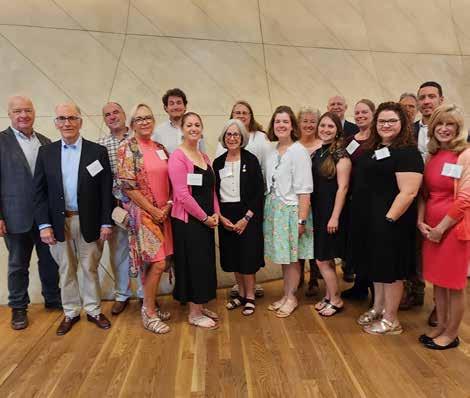
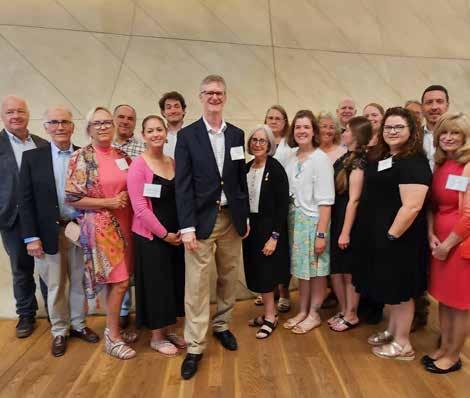
The Jewish Foundation for the Righteous selected 12 middle and high school teachers and Holocaust center personnel from five U.S. states as participants in its 2023 European Study Program in Germany and Poland from July 1 to July 15. Through lectures and visits to actual Holocaust sites, these educators gained a more profound understanding of the complex and tragic history of the Holocaust.
The program is a high-level, intensive, and immersive educational experience that includes visits to concentration camps, ghetto sites, and Holocaust memorials. Noted historian Robert Jan van Pelt, one of the world’s leading experts on the Holocaust, served as the accompanying scholar for the European Study Program.
The trip began with visits to Munich, Dachau, and Nuremberg where the group explored the buildings which once housed the Nazi headquarters and documentation centers as well as the White Rose Pavement Memorial, a cobblestone replica of pamphlets paying tribute to the ones passed out by the courageous White Rose student group that had resisted Nazi ideology during World War II.
The study program also included a historical tour through Poland and visit to the former Warsaw ghetto, the Jewish Museum in Warsaw, as well as educational expeditions through memorial sites and concentration camp vestiges,
including those at Treblinka, Tykocin, and Łopuchowo, Majdanek, Auschwitz I, and Birkenau.
The group met with some of the JFR’s Righteous Gentiles, non-Jews who saved Jews during the Holocaust, and toured through the remaining Jewish community in Krakow, a once thriving community that has had a presence in the area dating back 700 years.
Throughout the study program, participants had an opportunity to review and reflect on what they learned during their time at these important sites of the Holocaust, and how to bring those lessons into their classrooms.
Teachers selected for the program are English or social studies teachers at the middle or high school level, have taught for at least five years, are at least four years from retirement, and currently teach the Holocaust in their classrooms. Holocaust Museum staff also participated in the JFR’s Europeans Study Program. All participants are Alfred Lerner Fellows and have completed the JFR’s Summer Institute for Teachers.
“As we continue to move further away from the Holocaust, it is more important to teach this period in history to the next generation,” said JFR executive vice president Stanlee Stahl. “By focusing our efforts on helping teachers actually see the places where these complex events occurred, we believe it enhances
their understanding and enables them to be more effective instructors in their classrooms.”
“Visiting and studying at actual Holocaust sites helps teachers to better understand the enormity of the Holocaust and aids in making them more effective educators. We designed the program to help educators learn the Holocaust experientially so they can present it in a more meaningful and insightful way to their students and colleagues when they return to their schools.”
The JFR continues its work of pro-
viding monthly financial assistance to more than 110 aged and needy Righteous Gentiles, living in 11 countries. Since its founding, the JFR has provided more than $44 million to aged and needy rescuers. Its Holocaust teacher education program has become a standard for teaching the history of the Holocaust and educating teachers and students about the significance of the Righteous as moral and ethical exemplars. For more information, visit https://www.jfr.org/. ì
Compiled by AJT Staff
• Kelly Sorrell, of Pitiz Middle School in Vestavia, Ala.
• Angie Thompson, of Alma Bryant High School in Irvington, Ala.
• Melinda Walker, of Holt High School in Northport, Ala.
• Robin Blalock, of Escambia County Public Schools in Milton, Fla.
• Charles Hagy, of The Benjamin School in West Palm Beach, Fla
• Alicia Booker, of Lakota West High School in Hamilton, Ohio
• Rhaymen Altagracia-Yunes, of Atlantic City High School in Mays Landing, N.J.
• Sarah Coykendall, of the Holocaust Resource Center at Kean University in Montague, N.J.
• Sue Kenney, of Immaculate Heart Academy in Washington Township, N.J.
• Rachel Worrell, of Egg Harbor Township High School in Egg Harbor Township, N.J.
• Shawn Riggins, of Cumberland County Technical Education Center in Vineland, N.J.
• Caprice Erickson, of the Holocaust Museum Houston in Houston, Texas
On June 28, there was standing room only at the Sandy Springs Cinema & Tap House to hear introductory remarks by Kenny Blank, executive director of the Atlanta Jewish Film Festival. About 200 film evaluators have been selected to view potential Jewish films for the 2024 festival. This group, the AJFF Evaluation Committee, is responsible for reviewing hundreds of films and recommending a selection of them to the AJFF’s executive and artistic director, who will then decide which films will be presented in February and March of 2024 to the public.
The Jewish films for 2024 will be presented in a new format. The film festival will first be presented in various theaters from Feb. 14 to March 7. After that is completed, the film festival will be available for streaming from Feb. 27 to March 7. The new idea is to encourage people to first see the Jewish films in theaters before they are available virtually. For those people who enjoyed seeing films at the Tara Theatre, it will once again be avail-
able and used as one of the theaters for the AJFF.
In addition to Blank, the chairs of
the AJFF are: Lisa Cohen, an acclaimed journalist and filmmaker over a 35-year career; Hazel Gold, a former department chair at Emory University who has been affiliated with the AJFF for more than a decade; and Rabbi Dr. Brad Levenberg, senior rabbi of Temple Sinai.
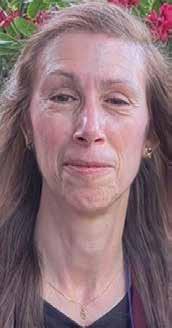

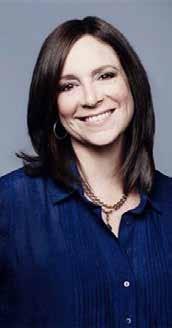
Rabbi Levenberg spoke about the vision and mission of the AJFF, suggesting that the films will be selected to provide social understanding to reflect the diversity and representation of Jewish themes, “building bridges” with film. He indicated that the 200 members of the Evaluation Committee are a diverse group themselves: 20 percent non-Jewish, 80 percent Jewish, 62 percent female, 37 percent male, and 1 percent transgender. The group is 10 percent LGBTQ+ and 20 percent are under 50 years old.
Three criteria are to be used. The first is whether the film is considered Jewish, which is to be judged very broadly. The second criteria is the quality of the film in terms of its story and its technical delivery. The final criteria is whether it is appropriate for the Atlanta public. The film evaluators will have to watch at least 20 films, although this writer was told that some evaluators watch hundreds of films.
The committee process and programming decisions are confidential, and may not be shared with family or friends, the general public, filmmakers, or other festivals. Interestingly, there are 200 film festivals like the AJFF worldwide, and the AJFF is considered one of the world’s foremost Jewish festivals.
Forbes’ Best-in-State Wealth Advisors, April 7, 2022, based on the 12-month period ending June 30 of the year prior to publication. Rankings are based on the opinions of SHOOK Research, LLC and selected from a pool of nominations as indicated in the methodology. Neither SHOOK Research nor Forbes receive compensation from the advisors or their firms in exchange for placement on a ranking. The rankings may not be representative of any one client’s experience and are not indicative of the financial advisor’s future performance. Investment performance is not a criterion for selection.

Forbes is a registered trademark of Forbes, Inc. All rights reserved. For more information on the selection methodology, see www.stifel.info/award-disclosures.
Neither Stifel nor its financial advisors provide legal or tax advice. Please consult your legal or tax professional if expert assistance is required.


Stifel, Nicolaus & Company, Incorporated | Member SIPC & NYSE | www.stifel.com
Over the next few months, this Evaluation Committee will be able to see hundreds of films on their computers in private and provide an evaluation to the AJFF of each of the films. Based on these evaluations, the group will meet sometimes in person, and sometimes over Zoom, to discuss the screen evaluations and make recommendations for various films to be finalists for the AJFF. It was made very clear that only members of the Evaluation Committee should screen these films since they are not available to anyone else under agreements the AJFF have with film providers. Each screener is responsible to give a minimum $36 taxdeductible donation to offset associated committee costs.
A key issue is deciding what constitutes a good Jewish film for the AJFF.
Not all the films for evaluation will be available at the same time. Films will be posted and removed on a rolling basis. Once enough evaluations are received by the AJFF, if there is unanimity that the film is either really good or really bad for the AJFF, it will be removed from additional viewing. Only when there is a divergence of opinion on the film will it be kept longer for additional evaluation. The reason for putting films on a rolling basis is to allow for the large number of films to be evaluated.
The point of this entire process is, of course, to find the very best films to present to the public for the Atlanta Jewish Film Festival. Readers can be assured that what they will see next February and March will be the best films selected for viewing based on a very thorough evaluation process. ì







It is a well-known fact among oncology patients that one of the effects of chemotherapy is that the patient’s immune system shuts down for the duration of the treatments. Thus, “if an oncology patient develops even a slight fever, they need to rush to the emergency room in order to undergo observation and receive treatment via antibiotics, if necessary,” explained Michal Geller, mother of Raaya Geller.
Raaya is a 16-year-old young woman from the town of Hispin in the Golan Heights who is so full of life and hope but has been living with osteosarcoma, a type of bone cancer, for the past year and a half. “For an oncology patient, making
July 31, 1988: Jordan’s King Hussein announces that he is giving up political claims to the West Bank, although he seeks to retain influence over Jerusalem. King Abdullah I annexed the West Bank and East Jerusalem in 1950.
Aug. 1, 1955: The development town of Dimona welcomes its first residents, who are recent arrivals from Morocco, as Israel tries to settle immigrants housed in tent cities. Dimona gains municipal status in 1969.
U.S. President Bill Clinton demonstrates a 3D camera to Israeli Prime Minister Shimon Peres at the White House on Dec. 11, 1995. //
 By Tsvika Israeli,
By Tsvika Israeli,
Israeli
Government Press OfficeAug. 2, 1923: Shimon Peres, the only person to serve as Israeli prime minister and president, is born in what is now Belarus. Peres makes aliyah in 1934, enters politics in 1941 and is first elected to the Knesset in 1959.
Aug. 3, 1945: Earl Harrison, sent by President Harry Truman to check on Europe’s displaced-person camps, reports that the rumors of poor treatment are often true. Tru-
it to the myriad number of appointments is hard enough, but if a patient gets an illness on top of their treatment, even a strong cold, then they have to go back once again to the hospital,” Geller explained.
This problem has existed for a very long time and there was no solution in sight until recently, when the CEO of United Hatzalah, Eli Pollack, and the organization’s president and founder, Eli Beer, decided that they were going to pick up the gauntlet and assist oncology patients living in the periphery by doing what the organization does in the field.
“Our goal, together with our partner Lahak, is to cut down response time so that people don’t have to wait to receive medical treatment. While we have been focusing on emergency medical response, we decided to undertake a new pilot project involving our helicopters that will cut down on travel time for families and children living with cancer, to and from the hospital. We hope that by cutting down the transport time, the patients and their families will benefit from a much easier journey and that it will free them from the time constraints included in traveling three to four hours to the hospital.”
man then calls for Britain to admit 100,000 Jewish refugees into Palestine.
Gives $18M Grant to Ben-Gurion University

A generous $18 million lead grant from The Leona M. and Harry B. Helmsley Charitable Trust will support the construction of the state-of-the-art Helmsley Computer Science Building on the university’s new North Campus. The Computer Science Department is one of the university’s key engines of future growth

Aug. 8, 1924: Lia Van Leer is born in Beltsy, Romania (now Moldova). She and husband Wim Van Leer create the Israel Film Archive in 1960, and she launches the Jerusalem Film Festival in 1984.
and is one of the largest departments at the university. This new building will enable increased student enrollment and expand research opportunities. The department’s graduates often join the workforce at companies in the Advanced Technologies Park adjacent to the campus.
Construction of the Helmsley Computer Science Building is slated to begin in the next couple of months. This stateof-the-art facility will be the largest building on the North Campus, with at least 60 offices and lab space for each faculty member. The building will also house the Computer Science Student Center, a modern learning environment designed to meet the unique needs of computer science students.
“This grant by the Helmsley Charitable Trust is a game-changer for the university, the Negev and the State of Israel. Following Helmsley’s impactful support of our research in robotics and Crohn’s disease, the Helmsley Computer Science Building is the cornerstone of the new North Campus and will enable many and varied collaborations with industry and the development of new technologies,” said Ben-Gurion University President Prof. Daniel Chamovitz.
Compiled by AJT Staff
Both Israelis and Palestinians celebrate the literary legacy of Yitzhaq Shami
Aug. 4, 1888 : Yitzhaq Shami, an early writer of modern Hebrew literature, is born to an Arabic-speaking father and a Ladinospeaking mother in Hebron. He fills his stories and poems with Arabs and Mizrahi Jews.
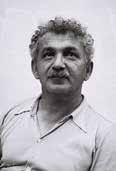
Aug. 5, 1953: Unit 101, a briefly independent special forces section of the IDF, is launched with about 20 soldiers under the command of Ariel Sharon to provide a rapid response to terrorist attacks.
Aug. 6, 2015: Stage and screen actress Orna Porat dies at 91 in Tel Aviv. Originally a German Christian, she moved to the Land of Israel with a Jewish British officer she met after World War II and converted.
Aug. 7, 1904: Ralph Bunche is born in Detroit. He wins the 1950 Nobel Peace Prize for negotiating a series of armistice deals between Israel and its neighbors in 1949 after his U.N. boss, Folke Bernadotte, is assassinated.
Aug. 9, 2006: Israel’s Security Cabinet approves an expansion of targets in the Second Lebanon War to achieve five goals, including the return of two soldiers kidnapped by Hezbollah at the start of the war in July.
Aug. 10, 1920: World War I’s victorious nations and the Ottoman Empire sign the Treaty of Sevres to break up the empire. The treaty incorporates the Balfour Declaration’s call for a Jewish national home in Palestine.
Aug. 12, 1944: Labor Zionist leader Berl Katznelson dies of a hemorrhage at 57. He developed the concept of moshavs and created a program for labor unity that served as the basis for the Mapai party.

As the president of the World Zionist Organization, Chaim Weizmann pushed for the formation of a Jewish Agency representative of all world Jewry.
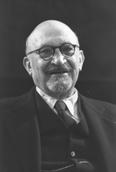

Aug. 11, 1929: The 16th Zionist Congress ratifies the creation of the Jewish Agency for Palestine, as called for in the League of Nations’ Articles of Mandate in 1922, with broad representation of world Jewry.
Aug. 13, 1995: Aharon Barak, a Supreme Court justice since 1978, is appointed the court’s president, a position he holds until 2006. He expands the court’s power to review government actions and protect civil liberties.
Aug. 14, 1944: U.S. Assistant War Secretary John J. McCloy notifies Leon Kubowitzki of the World Jewish Congress that the U.S. military has decided not to bomb Nazi death camps and their infrastructure.
On the eve of Tisha B’Av, commemorating the destruction of the first and second temples – widely attributed to discord between the Jewish people – the Israeli parliament voted July 24 to approve the first of a number of laws that will weaken the country’s Supreme Court, while strengthening the authority of the governing coalition.
The historical protests against the Israeli parliamentary approval reached a crescendo after 29 consecutive weeks of demonstrations by hundreds of thousands of critics who believe that the proposed judicial overhaul will weaken or destroy the country’s democracy. Polls indicate a majority of Israelis were against the judicial changes, although there were sporadic rallies of those in support of the legislation.
Immediately there were plans to appeal the government’s vote to the Supreme Court, which could set up a constitutional crisis if that court rules against the new legislation. Whatever happens in the coming months, the government’s vote signals that the country and its citizens will never be the same. Former Defense Minister Benny Gantz is quoted as saying the damage is already “irreparable.”
And, as if there weren’t enough drama in the country, it was reported that Prime Minister Benjamin Netanyahu had a pacemaker implanted over the weekend.
Since January, when Netanyahu’s government announced plans to enact several pieces of legislation that would give more power to his coalition at the expense of the judiciary, hundreds of thousands of Israelis have consistently, at least weekly for 29 weeks, protested in the streets all over the country. Critics – including from the military, intelligence, high tech, judicial, business, and medical industries – contend that passage of these proposals would weaken or destroy the country’s democracy.
In March, after Defense Minister Yoav Gallant warned the government that the threats of military reservists to refuse to serve were compromising Israel’s security, Netanyahu backed off from his legislative juggernaut and negotiations between his government and those opposed to the judicial overhaul sought a compromise. However, those negotiations ended weeks ago, and Netanyahu’s government continued to push forward on its plans that critics say would weaken, above all, Israel’s Supreme Court.
In the final days of July, Israel’s parliament, or Knesset, voted to restrict the Supreme Court’s grounds to review government decisions and appointments. It is known as the
“reasonableness” standard, which the Court, according to the Israel Policy Forum, applies to block government administrative decisions that are disproportionately based on political or personal interests over public interests. It is not used to strike down legislation.
According to Suzie Navot, vice president of research at the Israel Democracy Institute – founded by Atlantan Bernie Marcus -- the political motivation behind it is to minimize oversight of government decisions.

Navot was asked to meet with a large number of military reservists earlier in July to provide her professional explanation about the overhaul in general, and the “reasonableness standard” in particular. They did not ask specifically for her legal advice.
Days later, however, at an emergency meeting of the Israel Bar Association in Tel Aviv, Navot was quoted by Israeli media as stating, “Overturning the reasonableness standard is just the first act of whitewashing in the government’s plan.” She contended that this change “would make it easy for the government to take control of all of the gatekeeping positions. So long as the judicial overhaul is on the table, the fate of the elimination of the reasonableness standard is the fate of the entire government coup, and that’s how we have to treat this bill.”
Her charge, echoed by former leaders of Israeli security, intelligence, military and foreign services, inevitability underscored the fears of the protest movement that for months have shut down highways, clogged the areas inside and outside Ben Gurion Airport and congregated outside homes of Israeli government officials. Universities declared a strike. The protests reached a peak just before the Knesset voted when first hundreds, then as many as 80,000 -- both religious and secular -- Israelis marched roughly 40 miles from Tel Aviv to Jerusalem to be present at the Knesset for the final votes to approve the overturning of the reasonableness standard.
The Knesset’s summer session will end July 30, with the fall session not starting until October after the High Holy Days.
While polls consistently indicate that a
majority of Israelis oppose the government’s judicial overhaul, it is the near daily reports of more military reservists refusing to report for duty that shook the country. The evening before the Knesset was scheduled to launch its debate and vote, it was reported that as many as 10,000 reservists declared they are suspending their service.
Days earlier, more than 1,100 Israeli Air Force reserve officers – including 235 fighter pilots, 98 transport pilots, 89 helicopter pilots, 91 pilots serving in the flight school and 165 elite Air Force commandos – issued their letter threatening to suspend their reserve duty if the government moved forward to overhaul the country’s judiciary.
Reporting on the letter signed by Air Force reservists, Israeli media suggested that if the threat is fulfilled, the Air Force would no longer be prepared in case of war.
The chasm created by the judicial overhaul, which supporters claim is necessary, is widely seen as the gravest domestic crisis in Israel’s history. Some Israelis say they fear approval of the legislation could lead to a civil war.
Nadav Argaman, former head of the Shin Bet – Israel’s domestic intelligence organization – was quoted as saying that if the legislation is passed, “we’ll become a different country, so we’re not bound to the contracts we’ve been signed to,” referring to the thousands of reservists who have pledged to end their service.
Despite the fact that these reservists serve on a voluntary basis, they have still been condemned by members of Netanyahu’s government, a number of whom never served in the IDF themselves.
Israelis living outside the country – perhaps for the first time – have publicly rebelled in huge numbers against their government’s moves to overhaul the country’s judiciary system. Weekly protests around the world, many under the umbrella of a new grassroots group known as UnXeptable, have shared their photos and videos to show support for protesters in Israel.
A number of Israelis living in Atlanta
have joined the protests, sometimes in front of the Midtown office of the Consulate General of Israel Atlanta, other times at other Midtown locations and, recently, in Roswell and Alpharetta, all organized by volunteers. Bearing signs such as “Must Resist” and “Save Our Democracy Now,” dozens of Israelis living in Atlanta shouted “Democratia,” the Hebrew word for democracy.
The Atlanta protesters were united in their message; they just had to decide in which language to chant their refrains – English or Hebrew. Since that rally was primarily designed to be visually recorded and shared in Israel and around the world to mark the Atlanta group’s support for Israel’s democracy, Hebrew won out.
Many of the Israelis have lived in the Atlanta area for years, but their strong connection to their homeland has perhaps strengthened as their fears for its future have skyrocketed. Ari Kohn, who has lived in the Atlanta area since 1981, was quick to share that he is a retired Israeli Air Force pilot who signed one of the letters against the judicial overhaul.
Jerusalem-born Gil Weinberg, who has lived in Atlanta since 2003, spoke against the anticipated approval to overhaul the reasonableness standard. In mid-July at the Roswell rally, Weinberg said, “It is underestimated how dangerous it will be if it passes.”

Weinberg added that the fact Israelis of all ages participated in the mid-week, mid-day protest – called just the day before –shows that they are willing to use “any tool we can to stop this.”
In his address to Congress the week before the final votes were scheduled in the Knesset, Israeli President Isaac Herzog referred to the ongoing, dramatic protests in Israel as the “clearest tribute to the fortitude of Israel’s democracy.”
He was among those who attempted – even at the last minute -- to bring together proponents and opponents of the judicial overhaul to reach a compromise, or at least not rush through the legislation without a broad national consensus. ì
has a proven track record representing businesses and individuals in disputes against the Internal Revenue Service and various state departments of revenue. With a distinguished record of accomplishment and an in-depth understanding of the complexities within these practice areas, Hall will be an invaluable asset to MendenFreiman’s clients.
Prior to joining MendenFreiman, Hall was a partner at Moore Ingram Johnson & Steele, LLP.
MendenFreiman LLP is pleased to announce that Kenneth D. (Kenny) Hall has joined the firm as counsel in its business law, real estate and secured lending, and tax planning practice areas.
Hall brings a wealth of experience and expertise to the firm, particularly in the realm of corporate law and commercial transactions. His practice has primarily focused on advising businesses and business owners on capital raises, acquiring and selling businesses, tax-efficient capital restructuring and reorganization and corporate formations. He also
He received his LL.M in taxation from the University of Florida, his J.D. from Mercer University, undergraduate degree from the University of Georgia. Hall is licensed to practice in the State of Georgia and is also admitted to the Georgia Supreme Court and the United States Tax Court.
“The decision to bring Kenny on board demonstrates our commitment to the collective vision and goals of our firm,” said Lance G. Einstein, co-managing partner. “By adding Kenny to our team, we believe we can better meet the evolving needs of our clients and enable them to empower their future with our help as trusted legal counsel.”
On July 28, volunteers organized by Atlanta United joined Soldiers’ Angels to distribute 75 pounds of food, fresh fruits and vegetables, meats, and non-perishables to 200 pre-registered veteran and military-connected families. The event was sponsored by Chick-fil-A Atlanta, who was on-site giving out complimentary Chick-fil-A chicken sandwiches and waffle potato chips to every car with a veteran that stopped by. The Chick-fil-A Cow also made an appearance.
Soldiers’ Angels, the national nonprofit that provides more food exclusive-
ly to veterans than any other organization in America, provides an easy, no-cost way for 200 Atlanta-area veterans, active-duty service members, guardsmen, and reservists in need to receive food assistance.
Atlanta United and Chick-fil-A Atlanta-area restaurants are sponsoring two more Soldiers’ Angels military and veteran food distribution events on Aug. 25 and Nov. 17.
To learn more about the Tackle Veteran Hunger campaign, visit www.atlutd.com/ community/tackle-veteran-hunger.

Top 100 U.S. law firm Akerman is pleased to announce the appointment of Jason Lichtstein as office managing partner in Atlanta. Lichtstein is a partner in the firm’s real estate practice group and has been with the firm for nearly 20 years.
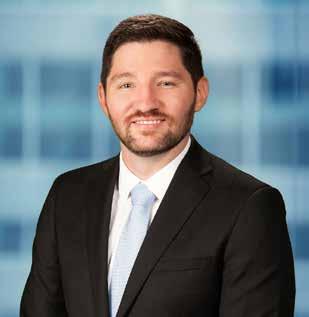

As office managing partner, Lichtstein will continue to strengthen Akerman’s relationships with business and civic leaders in the Atlanta market while guiding the firm’s strategic direction locally. He will also play an important role in managing the office’s strong philanthropic and pro bono efforts, and he will continue serving clients through his environmental law practice.
“Atlanta is a thriving market with a
diverse and dynamic array of businesses and industries,” said Akerman chairman and CEO Scott Meyers. “Jason’s energy, insight, and leadership will help us to build upon our strong foundation and high-trust culture to drive further growth and success in Atlanta.”
Akerman opened its Atlanta office in 2018 with three lawyers and has since grown the office to more than two dozen.
“I have built my career at Akerman, so I consider it an honor and privilege to be asked to lead this office,” Lichtstein said.
“Going forward, my most significant goals will be to leverage our firm’s culture, talented professionals, and success in the Atlanta market to enhance the ongoing growth of the office, and to ensure
that our Atlanta team continues to delight our clients, support our colleagues, and give back to our communities.”
Lichtstein focuses his practice on the cleanup and redevelopment of brownfields and other contaminated sites in the Southeast. His practice includes a broad range of environmental transactional, environmental regulatory compliance, and state incentives matters, as well as emerging, cutting-edge environmental law and policy developments relating to Environmental, Social, and Governance (ESG), climate change, and sustainability issues. He is a member of the Georgia and Florida bars and has been ranked as a leading environmental lawyer by various industry publications, including Cham-
On July 9, the opening ceremony for the 41st JCC Maccabi Games, the world’s largest Jewish youth sporting event co-hosted by JCC Association of North America and Maccabi World Union, was held at the International Convention Center Haifa. In conjunction with the celebration of Israel’s 75th anniversary, this year’s Maccabi Games galvanized more than 1,000 Jewish teens from 10 countries on four continents (North America, Africa, Europe, and Asia) including those from Ukraine and, for the first time, the Abraham Accords country of Morocco, whose young athletes were able to partake in the festivities due to the JCC Association’s partnership with BBYO.

Highlights of an opening ceremony that was equal parts moving and aesthetically pleasing included a recorded address from President of Israel Isaac Herzog; Washington Wizards small forward and Israeli native Deni Avdija lighting the torch to signify the official opening of the Maccabi Games; a tribute to Shlomit Nir-Toor, an Israeli former Olympic swimmer and Maccabiah champion, who represented her homeland in the 1968 and 1972 Olympics, the latter of which coincided with her surviving the Munich Massacre at the Olympic Vil-
lage; as well as a tribute to Nicol Faiglin, the runner-up to the 2022 World Youth Fencing Championships and secondplace winner of the European Girls’ Fencing Championship.
Meanwhile, the hundreds of athletes and coaches on hand were serenaded by music from the globally recognized and award-winning Shalva Band, which features musicians with disabilities, and Mayoumana, a very popular interactive performance group.
This year marked both the return of the JCC Maccabi Games to Israel for the first time since 2011 and the largest Israeli delegation to ever represent the country (11 different communities were represented) in the history of the Games.
“The JCC Maccabi Games are perhaps the most extraordinary Jewish peoplehood initiative of our time,” exclaimed Doron Krakow, president and CEO, JCC Association. “Drawing teens from JCC communities across North America, Israel, and around the globe, the Games bring us together through competition, service, and a profound encounter with the wider Jewish world. To be returning to Israel as part of the ongoing celebration of the country’s 75th anniversary year and the enduring fulfillment of the dream of the modern Zionist movement is a source of enormous pride for all of us.”
Selig Enterprises and its joint venture partner, GID, announced first residents will move into Westbound at The Works this October, with leasing starting this week. One- and two-bedroom apartments are now listed on the property’s new website (livewestbound.com) and interested residents can visit the preview center located at 202A Chattahoochee Row to see a model unit and schedule a tour of the building. The preview center is open seven days a week (9 a.m. to 6 p.m., Monday through Friday; 10 a.m. to 5 p.m. on Saturday; and 1 p.m. to 5 p.m. on Sunday.
Located at the property’s main entrance along Chattahoochee Avenue and Chattahoochee Row, the 306-unit community will feature a mix of 70 percent one-bedroom and 30 percent twobedroom apartments, ranging in size from 731 square feet to 1,353 square feet.

Senior vice president of Selig, Malloy Peterson, said of Westbound at The Works, “Bringing residents to The Works is an important next step in building a thriving community on the Upper Westside. We have created a true-
to-Atlanta, mixed-use experience at The Works with best-in-class office, retail, dining, and entertainment, and we’re excited to welcome residents this fall.”
The five-story residential project will include a 547-space parking garage and state-of-the-art amenities that overlook The Camp, the property’s one-acre greenspace. Westbound at The Works mirrors the unique, industrial aesthetic of the neighborhood, featuring modern dark bronze windows, fiber cementitious panels with pops of orange and charcoal gray brick. Residents will have access to private upscale amenities, including an open-air TV lounge, indoor/ outdoor fitness room, club room, sports bar, co-working center, communal kitchens, and a pool courtyard.
For additional information, please visit www.livewestbound.com or follow the project on Instagram @livewestbound. P lease follow The Works on Facebook, Twitter and Instagram or visit the website at www.theworksatl. com.
Compiled by AJT Staff
The Sandwich Project hosted a milestone event on July 21 at the Big Green Egg Culinary Center as the organization celebrated the making of its one millionth sandwich for those in need.

The power of a simple sandwich to make a difference in someone’s life is undeniable. The Sandwich Project, an initia-
tive based in metro Atlanta, has reached an extraordinary milestone by collecting and donating one million sandwiches to individuals and families living with food insecurity.
Since its inception in April 2020, The Sandwich Project has been driven by the dedication and compassion of thousands


of volunteers who generously contribute their time and resources to the community. Each week, volunteers prepare thousands of homemade deli sandwiches, accompanied by protein bars and fresh fruit. The Sandwich Project then distributes the sandwiches to local nonprofits to reach those in need.

“The act of making a sandwich holds tremendous power to create positive change,” says Lisa Hiles of the Sandwich Project. “We believe that anyone can make a difference, and a sandwich is a tangible way to contribute to the wellbeing of our community.”
Compiled by AJT Staff

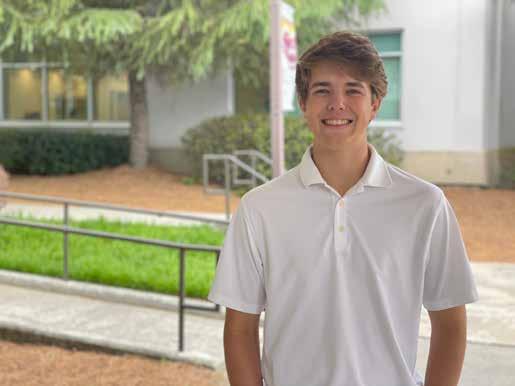

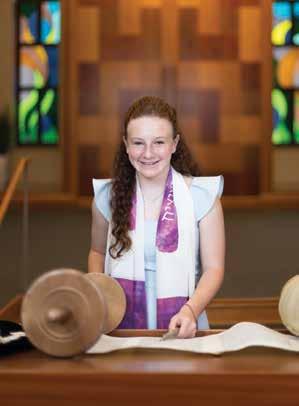


The final box score of this summer’s MLB All-Star Game may reflect the Atlanta Braves’ franchise-record, eight-player contingent having a negligible impact on the exhibition’s outcome, but the 93rd Midsummer Classic held on July 11 at Seattle’s massive T-Mobile Park still goes down as an iconic evening in Atlanta sports history.
David Ostrowsky
The Braves entered the break on pace for 109 wins (a total that would eclipse the current franchise-best 106-win mark set by the ’98 club), after having gone 28-7 since June 1. So, it was only fitting that the best team in baseball, one fueled by a relentless lineup projected to break MLB’s single-season home run record and supported by a patchwork pitching staff, had six position players (starters Ronald Acuna Jr., Sean Murphy, and Orlando Arcia and reserves Ozzie Albies, Matt Olson, and Austin Riley) and two pitchers (Spencer Strider, Bryce Elder) to match the 2008 Chicago Cubs, 1960 Pittsburgh Pirates, 1956 Cincinnati Reds, and 1943 St. Louis Cardinals for the most All-Stars for a National League team in a season.
Only six teams (all from the American League) have had more than eight All-Stars in a year. Perhaps if Atlanta’s two frontof-the-rotation starters (Max Fried, Kyle Wright) and most effective reliever (Jesse Chavez) were healthy, this year’s Braves would have set the National League record.
There simply hasn’t been a roster this deep and talented in years, maybe even decades.
“They [the Braves] have the best offense I’ve ever seen probably in my time in the big leagues,” said St. Louis Cardinals third baseman Nolan Arenado the day before he and the other NL All-Stars edged their AL counterparts, 3-2, to deliver the Senior Circuit its first ASG win since 2012. “They’re definitely different. Credit to that organization for getting all those guys.”
“I think I saw they [the Braves] were the first team to 60 wins, and I’m not surprised,” added the Arizona Diamondbacks young ace pitcher Zac Gallen, who started the game for the National League. “It’s a good team from top to bottom. They play good defense, hit, pitch, it’s awesome. Some of these guys, it’s fun to watch.”
It made sense that nearly a third of the NL All-Star roster was comprised of Braves. The rest of the country needed to see what has kept the city of Atlanta abuzz this sum-
mer.
“Especially around the stadium – I don’t live over there – but when I’m over there you can tell people are excited coming out to games. It’s a lot of fun to play in front of,” said Elder, who actually began this season in Triple-A Gwinnett.
The Braves came into the All-Star break having hit a homer in 26 consecutive games. On the second pitch of the game, it appeared Atlanta’s historic power surge would be on full display when likely NL MVP Acuna Jr. smashed a deep drive to right. However, it wasn’t to be as Adolis Garcia, of the Texas Rangers, leapt up against the right field wall to snag Acuna Jr.’s drive.
“The sun was really tough out in right field,” García said in Spanish after the game. “At first, I really couldn’t see the ball, but I just followed it and was able to make the catch.”
Indeed, a blinding sun, courtesy of the 5 p.m. West Coast start made fielding – and hitting against All-Star pitchers – a cumbersome task.
“They [Braves] have a mighty offensive team. They have a great team. In their defense, it was really tough to see at that time that they were hitting, all those guys,” AL manager Dusty Baker said afterwards when asked about his pitching staff holding the Braves’ hitters to merely one hit. “Because everything’s a blur at that time. The sun’s not helping, the lights don’t help, so that was a tough time to see. These are the best of the best. Those Braves, you know, I don’t want to face ‘em every day. We faced ‘em and swept ‘em when they were a little cold over there in Atlanta.”
That the Braves All-Star sluggers were uncharacteristically cold in Seattle that evening didn’t diminish the magnitude of the franchise having eight All-Stars (Strider and Elder were on hand but didn’t pitch due to having recently started before the


break) and, in the fifth inning, comprising the entire National League infield – an even more impressive feat considering the recent departures of Freddie Freeman and Dansby Swanson.
“It was one of the most special moments this year so far,” Albies told The Atlanta Journal-Constitution afterwards. “To have the whole infield playing in the All-Star game is pretty sick. It was a great time and a great moment to have that together.”
As part of the all-Braves fifth-inning infield, Olson replaced Freeman at first – just as he did in the Braves’ everyday lineup a season and a half ago.
For Olson, the lanky, sweet-swinging first baseman who attended Parkview High School in Lilburn, his first All-Star appearance as a Brave took on special meaning… even though he struck out in his only plate appearance before getting lifted for New York Mets slugger Pete Alonso.
“I think 10-year-old Matt thought it’d be really cool,” said Olson. “I always pictured myself in a Braves uniform. You want to picture yourself in the All-Star Game doing all this stuff. To have them meshed together is cool.”
Atlanta’s lone offensive highlight was a sixth-inning single by the third baseman Riley, who, as a 26-year-old, presumably has many All-Star Games in his future.
“He [Riley] has got elite power, but defensively he’s just gotten so much better,” noted Arenado. “I mean he’s really good over there. The one thing I respect about him, and their team, is that they play every day. He doesn’t really take a whole lot of days off. He is one of my favorite players in this game.”
In a bit of irony, perhaps the most notable contribution by a Brave came on defense when Murphy, the club’s first-year catcher who’s having a career year, gunned down
Tampa Bay Rays outfielder Randy Arozarena attempting to swipe second in the bottom of the first. In doing so, Murphy became the first catcher to record a caught stealing in an All-Star Game since Alex Avila pulled off the trick in 2011.
“Yeah, I mean he [Murphy] is an incredible catcher,” Colorado Rockies catcher and All-Star Game MVP Elias Diaz acknowledged about his All-Star teammate with whom he shared catching duties. “He has a lot of skills, a lot of knowledge. So being able to be around him and kind of learn from him, understand how he plays his game, it’s been an incredible experience for me. I’m coming away from it really satisfied with the amount of knowledge that I take from him, that I’ve learned from him to be able to move forward in my game as well.”
With a passel of uber-talented twentysomethings inked to long-term contracts, the Braves promise to have sizable contingents at future All-Star Games. And, after next year’s game at Globe Life Field in Arlington, Texas, it is entirely possible that the 2025 All-Star Game will be played at Truist Park.
While a formal announcement will likely come this winter, the Braves’ home – along with Chicago’s Wrigley Field, Baltimore’s Camden Yards, and Toronto’s Rogers Centre – is being considered as a potential host for the midsummer spectacle.
If the Braves host the All-Star Game in 2025 – something that was originally supposed to transpire in 2021 -- it would mark the third time the franchise has done so, the other two times being 1972 and 2000.
“Atlanta is in the mix of clubs for the ‘25 All-Star Game,” MLB Commissioner Rob Manfred told the Baseball Writers’ Association of America on the morning of this year’s game. “I’m not prepared to go past that for right now.” ì
With just over two months remaining in the 2023 MLB season, the Braves’ three Jewish players (Max Fried, Kevin Pillar, Jared Shuster) have been together on the active big-league roster for less than a week. While Pillar, per his surname, has been a pillar of skipper Brian Snitker’s bench all season, Fried has endured an injury-riddled campaign while Shuster, currently residing in Triple-A Gwinnett, has had an up-and-down rookie season.
And with July melting into August, it’s quite possible that the trio of Jewish Braves won’t overlap until next season.
Undoubtedly, the club’s pursuit of a second World Series title in three years largely hinges on Fried’s golden left arm. After exiting Atlanta’s Opening Day win against the Washington Nationals in the middle of the fourth inning with a hamstring strain, Fried returned to action on April 17 and didn’t allow a run over his next three starts. However, after an uncharacteristically subpar outing against the Baltimore Orioles and Dean Kremer (Team Israel) on May 5, during which he sustained a left forearm strain, Fried was placed on the 15-day injured list and subsequently shelved for the next couple months after moving over to the 60-day IL.
It wasn’t until earlier this month –during a July 9 start for Triple-A Gwinnett -- that the All-Star southpaw, who finished runner-up in the National League Cy Young voting last season, initiated his rehab work. Over 35 pitches, Fried worked around two walks and a single before getting pulled in the second inning without yielding a run.
The two-month absence was Fried’s longest time between appearances since Tommy John surgery in 2014 sidelined him for a year and a half when he was a can’t-miss prospect in the San Diego Padres organization.
“As an athlete and a competitor, you always want to be helping your guys out. You want to be in the fire, be part of the mix,” Fried said after his first rehab outing against the Omaha Storm Chasers. “That’s kind of been the hardest part. Knowing how well and amazing they’ve been performing, you can take your time. But I want to be part of it. I’d rather be in it than watching from the sideline.”
With the Braves holding a commanding NL East lead, the club is not rushing Fried back. Less than a week after the Gwinnett start, the slender lefty threw
With his first two big league stints behind him now, rookie Jared Shuster is primed to give the Braves meaningful innings if not this season, then perhaps next year // Photo Credit: Matthew Grimes/Atlanta Braves
even fewer pitches (30) but was sharper than during his first rehab outing, firing 23 strikes while only allowing two hits and not walking a batter. Though there remains some uncertainty with the exact timing, Atlanta’s ace, who turns 30 this January and has one year of arbitration remaining before hitting free agency, has been projected to make his highly anticipated return by late July/early August.
Of course, that Fried’s return is imminent makes Shuster’s chances of rejoining the Braves rotation even slimmer.


Though Shuster posted a 5.00 ERA over two stints with Atlanta this spring, his second time-around was a marked improvement from his first two big-league outings in early April when he yielded a combined eight earned runs while walking nine. As it stands, the rookie season highlight for Shuster came on May 21 when the Braves’ 2020 first-round draft pick pitched six innings of one-hit ball against the Seattle Mariners to record his first MLB win.
“He [Shuster] came to Spring [Train-
As one of the most experienced players on a young Braves roster, Kevin Pillar has been a model of professionalism and consistency all season long // Photo Credit: Matthew Grimes/Atlanta Braves
ing] thinking he had no shot of breaking with the team, and he did,” Braves catcher Travis d’Arnaud remarked afterwards. “For him to grow from that is pretty special. Each start, he’s gotten better and better. It’s really good to see him grow.”
Barring any further injuries to the Braves’ deep pitching rotation, Shuster, who has largely struggled since returning to the minors, will likely not return to Atlanta this year. However, starting on Sept. 1, MLB 26-man rosters do expand to cover 28 players – teams can carry 14 pitchers – which could bolster Shuster’s chances of getting called back up.
Pillar, meanwhile, has come as advertised – a team-first journeyman who plays a solid left field and provides occasional power from the right side. The 34-year-old Pillar, who broke into Major League Baseball a decade ago for the Toronto Blue Jays, is, at this point of his career, strictly a part-time player often called upon to pinch-hit against lefties. The veteran outfielder’s most memorable pinch-hit as a Brave, without question,

While the Braves were able to win the 2021 World Series without star outfielder Ronald Acuna Jr., they’d rather not have to do the same this year without the services of their best pitcher, Max Fried // Photo Credit: Matthew Grimes/Atlanta Braves
occurred back on May 6 when he clubbed his 100th career home run in the eighth inning of a 5-4 win over the Baltimore Orioles.
“I know 100 is kind of insignificant to a lot of people, when you think about the greats and how many home runs they’ve hit,” Pillar said after his early season milestone that also proved to be the game-winning hit that evening. “But for a kid who was drafted in the 32nd round, and never thought he would be in the big leagues 10 years later, to have 100 homers — I’ve never been a big home run guy, it just kind of speaks to maybe some consistency, being able to stay on the field, accumulating enough at-bats, and maybe coming into a little power as I got a little older, a little more mature.”
Looking ahead beyond 2023, it’s quite possible that yet another Jewish ballplayer may one day don a Braves uniform: with its sixth-round pick in the recent MLB Draft the franchise selected Lucas Braun, a right-handed pitcher out of Cal State Northridge. ì
plus bodies worldwide — including more than two dozen U.S. states — have, in varying ways, adopted or endorsed the definition.
Dave SchechterFrom Where I Sit
Four months after a bill to define antisemitism was kicked to the curb by the Georgia Senate, a mix of rebuttal, resentment, and recrimination is being vented.
Republican Sen. Ed Setzler makes no bones about actions he felt were necessary to derail legislation that he labels as “outrageously broad” and “dangerously vague.”
Jewish Democratic Rep. Esther Panitch, meanwhile, insists that House Bill 30 was mischaracterized, misunderstood, and mistreated in the Senate.
The goal was to place into Georgia’s legal code a reference to the “working definition” of antisemitism created in 2016 by the International Holocaust Remembrance Alliance. An estimated 1,100-
Claiming support from 90 percent of the Jewish community, proponents touted the legislation as a tool to help prosecutors and state agencies determine whether a crime or discriminatory act was motivated by hatred of Jews.
Opponents shared Jewish intramural arguments about defining antisemitism, and legislators heard concerns — rejected by the bill’s backers — that the measure could be used to curb free speech, particularly concerning Israel.
A few weeks ago, after Marietta Daily Journal columnist Dick Yarbrough fingered Setzler for the legislation’s failure, the latter fired back in an op-ed.
“Just because a bill sails through one chamber of the legislature by a vote of 136-22 does not mean that the bill has been adequately vetted and is ready for prime time,” Setzler wrote. “This is especially true of emotionally sensitive bills like antisemitism which, by its very na-

ture, is very difficult to criticize in public or make changes to in the face of highly energized advocates who care deeply about an issue but are sometimes ill-informed of important legal details.”
A ticked off Panitch posted a 30-entry response on Twitter. Setzler, she began, “casts advocates and authors of HB 30 as dodgy, intentionally ignorant, and bad faith actors.”
The Acworth Republican, she continued, “claims that the [Senate] Judiciary committee modified HB 30 to make it a sound legal definition. That is an outright and frankly disgusting lie. They did not change any legal language. In an act of utmost audacious pomposity (chutzpah) what Setzler did was amend the IHRA definition itself.”
The IHRA definition reads: “Antisemitism is a certain perception of Jews, which may be expressed as hatred toward Jews. Rhetorical and physical manifestations of antisemitism are directed toward Jewish or non-Jewish individuals and/or their property, toward Jewish community institutions and religious facilities.”
The strategy of incorporating a reference in HB 30, rather than the definition itself, was intended to prevent tinkering with its language — which is what happened.

In the Judiciary Committee, Setzler amended the bill to include the definition itself and replace “certain” with “negative.”
Speaking recently to the AJT, Setzler said: “The IHRA definition doesn’t require hate or violent action, all it requires is a ‘certain perception’ of Jews. ‘Certain perception,’ is that a fair standard?”
Jewish groups point out that antisemitism can be rooted in such “positive” perceptions of Jews as powerful, controlling the finance system, news media, and entertainment industry.
Rather than accept those changes, HB 30’s sponsors requested that their bill be withdrawn.

But like Monty Python’s parrot, the bill was not dead, but merely sleeping. On another day, in a different committee, a version of the bill advanced — but it never received a Senate floor vote. (The legislative clock ran out on a similar effort in 2022).
Panitch concluded her Twitter thread: “It takes a special person to vote to make a community less safe, then gaslight them about what and why he did it. Shame on Sen. Setzler b/c the Jewish community deserves better.”
The Fulton County Democrat told the AJT that she remains “perplexed as to why Setzler took it upon himself to redefine an experience he has never had and can never have, for millions who have suffered from antisemitism, as if he individually knows better.”
Setzler also found himself in hot water with the The Temple.
In his op-ed, Setzler wrote that: “I have had the pleasure of discussing the antisemitism issue in a 75-minute town hall meeting with a rabbi and members of the oldest Jewish synagogue in Atlanta, . . ."

Rabbi Peter Berg, senior rabbi of The Temple, responded in the Marietta newspaper, saying that Setzler “mischaracterizes the conversation that took place with one of our rabbis. To be clear, The Temple wholeheartedly supports HB30 including the use of the International Holocaust Remembrance Alliance (IHRA) definition of antisemitism (Jew Hatred) as written. Hard stop. It is essential that we pass HB30 as written.”
Setzler told the AJT that he did not mean to suggest that The Temple supported his position, adding that HB 30 was only one topic in the online session.
In our summer swelter, nothing suggests that the vapors resulting from the antisemitism debate will dissipate before the General Assembly reconvenes in January and efforts to pass the legislation are renewed. ì
For every pursuit, SCAD offers students a wonderland of resources designed to surpass top studios, startups, and firms.
SCAD.EDU

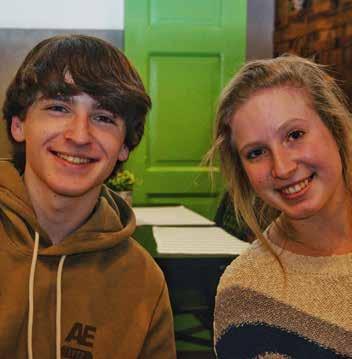
 Marcia
Caller Jaffe
Marcia
Caller Jaffe
As the cloud of antisemitism swirls about world events, community leaders set in motion powerful actions to educate young hearts and minds.
With the adage, “Better to light one candle than curse the darkness,” members of the Jewish community connected to The Westminster Schools worked with school officials to develop an immersive course focused on the history of antisemitism and the neuroscience of prejudice. The course is part of Westminster’s JanTerm—an intensive, three-week course of study in which Upper School students focus on a single topic in great depth through a cross-disciplinary approach that incorporates experiences both in the classroom as well as off-campus.
The Voices of Resilience course was developed three years ago by Westminster faculty members Dr. Kasia Darlak and Dr. Nathan Vigil with inspiration and a seed gift provided by Jack and Lynne Halpern. Other Jewish alumni and friends of the school—Lon and Debbie Neese, Eva and Robert Ratoyni, Joyce and Jay Schwartz, Steve and Linda Selig, and The Chatham Valley Foundation—offered additional financial support for the program, enabling the school to send students and faculty escorts to Poland and Czech Republic.

This year’s class, comprised of 18 mostly non-Jewish students, were escorted by faculty members and course creators, Darlak and Vigil, as well as school counselor, Jeremiah Neal, and director of performing arts, Adam Koplan (recently featured in the Atlanta Jewish Times (June 30).
Koplan noted the popularity of the course as they had 60-plus applications for the 18 spots. He stated, “Having these brilliant, curious Westminster students, 85 percent of whom were not Jewish, learn about Ashkenazi history and culture, alongside the tragedy of the Holocaust, made the trip especially powerful. Some of our Jewish guides and hosts kept remarking that they wished more interfaith and non-Jewish groups would make the trek and I think they were especially impressed with us.”
The trip to Poland began with a visit
to the Polin Museum of History of the Polish Jews, providing an overview of Jewish life in Europe, then visits to the Majdenek and Auschwitz camps. Students were struck with the freezing winter temperatures and the lack of clothing the victims experienced, along with the other brutal horrors of extermination camps.
Next the group volunteered at the JCC of Krakow where they packed food for Ukrainians and witnessed another
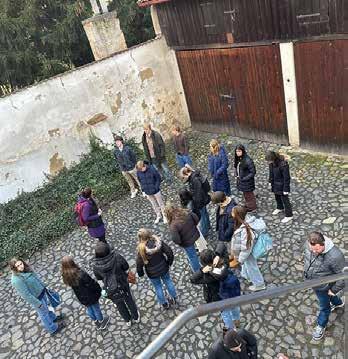
survivor’s firsthand story which inspired the students to “not just see the negative, but also find the positive.” A trip highlight for most students was a Shabbat dinner in Prague hosted by Chabad in which students stated that seeing some of the beautiful and spiritual aspects of Judaism helped them contextualize the modern fight against antisemitism. One junior noted the privilege of being able to get on a bus and drive away from the camps “but no longer as a bystander.”
Holocaust survivor Robert Ratonyi said, “I didn’t graduate from Westminster, but my son, David, did (1982). I got involved with Voices of Resilience through my relationship with The Breman Museum where the students meet prior to the trip.”
In 2022, Ratonyi was asked by The Breman to address students, trip sponsors, parents, and teachers prior to the trip overseas.
He elaborated, “After the trip, I
spoke with students and absorbed their feedback. It’s an emotional experience to listen to these smart, articulate students describing it as ‘life changing.’ I was asked to dedicate a copy of my book, ‘From Darkness Into Light,’ to each student....this is a fantastic program to teach students about the Holocaust; the best I have ever seen.”

Trip co-sponsor Jay Schwartz said, “My brothers and I attended Westminster, and our mother went to Washington Seminary (a precursor). My own children went there as well. Regarding the trip, we all believe it’s important for the school’s development of understanding, diversity, and acceptance. Yes, attitudes have changed. In my time there, one had to be Christian to teach. This trip fosters understanding and needs to continue to

evolve, so we never forget.”
Jack and Lynne Halpern hosted the students at their home on the Sunday after the trip. Jack Halpern stated, “Each of them talked about what was the most meaningful part of the experience for them. The trip’s teachers, Kasia Darlak and Nathan Vigil, are gifted educators and their commitment to this project is what made it so impactful and successful. The trip was truly a life-changing experience for those involved.”


As part of the course’s conclusion, the Voices of Resilience class shared how the experience impacted them and led the Upper School student body in discussions about battling antisemitism.
Ratonyi laid out the challenge, “Maybe some of the other private schools can step up and sponsor similar trips.” ì
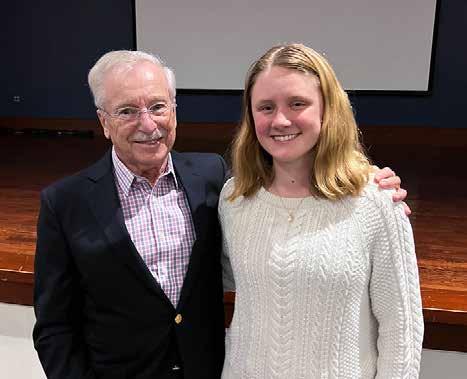


 By Marcia Caller Jaffe
By Marcia Caller Jaffe
If you don’t know what resilient infrastructure and supply chains are about, distress not -- Dr. Ilan Stern comes to the
rescue with his formal physics education. His prescient selection of his area of emphasis is among the highest profile in our “greening world,” weighing the pros and cons of electric cars, for example.
What the heck will we do with those wasted batteries? Dr. Stern is on the road to being part of the solutions.
Stern was born in New York City and moved to Atlanta in 1991, when he was
around 10 years old. Stern claims Atlanta as “home base” as he spent his formidable years at The Epstein School and Walton High School, then headed north for Buffalo State University, a small NCAA
Division III school, to play basketball. He then transferred to The Ohio State University where he completed a bachelor’s in physics and astrophysics. Stern marched on to Tulane University and completed a master’s and PhD in applied physics, focusing on thin film deposition and characterization for energy-based device applications.
Upon completion in 2012, he was hired as a post-doc at Georgia Tech Research Institute, and has since advanced to a principal research scientist, and chief of the Resilient Infrastructure and Supply Chain Unit. Stern leads the RISC team, a research group comprised of faculty members and up to eight students, including graduate, undergraduate and high school.

Stern explained, “Most of my work is research focused, however, I built and taught a class on advanced battery fabrication and characterization. I lead a portfolio of federal- and state- and industrysponsored contracts primarily focused on energy systems. More specifically, my current research focuses on all solid state batteries. These are the batteries of the future due to their intrinsically higher energy density, and high safety factor compared to traditional liquid electrolyte Li-ion [lithium-ion] batteries.”
Dr. Stern does not currently drive an EV but is “anxious to get into one.” He is working diligently, in his unit and nationally, to build out a national or domestic supply chain to remove the dependency on China for supply products. Stern thinks, though, that manufacturing batteries eschewing the Chinese will raise costs as they have been developing
the infrastructure for years, leading to a steep drop in prices.
He explained, “In addition, China’s poor labor conditions allow for well below market compensation for their workers. In addition to the solid state innovation, we are working on full life-cycle models to build out the capabilities and enhance the efficiencies for recycling, as we are expecting to see a sharp increase in the number of EVs on the road over the next decade. What to do with those batteries in endof-life stage will be a great indicator as to how the manufacturing and utilization will be done for future generations.”
Georgia news is full of headlines about the influx of billions of new industry dollars pouring into the state (SK Battery, for example.). Who is paying for this research? Stern’s group has both industry and federal contracts. The group likes to work with industry professionals to ensure they are addressing the needs of the manufacturers, and how to make their processes more efficient. They do this with parametric system modeling, as well as cost modeling forecasting.
Stern concluded, “This is all in conjunction with the performance models we build for the fundamental materials.”



Outside of work, Stern’s spouse, Marsha, is a physician at Emory, and runs a collaborative clinic at Grady Hospital (internal medicine and psychiatry). They have three boys: Aiden (7), Zachary (5), Benjamin (1). Stern coaches Aiden and Zachary’s baseball teams, and Aiden’s summer travel baseball team. As “super dad” Stern continues to be an avid basketball player, he also knows his way around the tennis court. ì

 By Marcia Caller Jaffe
By Marcia Caller Jaffe
Fourteen-year-old Jacob Sherman’s resume ends with “extremely creative all around, funny, friendly, works well with others, incredibly motivated, passionate about theatre, does accents, plays the saxophone, makes puppets, paints.”
The body of the resume is packed with impressive roles in the Actor’s Express, Orbit Arts Academy, Lyric Theatre, and, most recently, in the much heralded “Prayer for the French Republic,” where he played the role of Young Pierre, a serious child who had to grow up too soon.
Jacob Sherman began acting at the age of seven at Orbit Arts Academy, an organization run by former Broadway actors and skilled teachers. He initially took classes in improvision with other children his age. That summer, he enrolled in his first summer camp where, after two weeks, the children staged a performance of “Alice in Wonderland,” where Sherman played the doorknob. He was hooked.
Scott Sherman, Jacob’s father and
an attorney, said, “Orbit has changed his life and our family’s life. As shown in his resume, he has been cast in an extensive number of shows both at Orbit as well as professionally. Professional performances have included shows locally as well as
in New York.”
At 14, Jacob Sherman attends Capstone Academy in a concentrated, threeday-per-week school that allows him to train at Orbit with flexibility so he can accept professional theater roles that

have intense schedules. He takes an extensive number of classes, including acting, role development, dance, strength training, and more. He is also a part of Orbit’s Senior Company, which requires substantial commitment weekly to train-
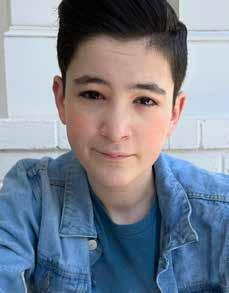
ing and performance. Jacob has extensive training in singing and dancing in addition to acting.



Jacob Sherman’s dream is to perform on Broadway, no matter the role.
Scott Sherman said, “He knows it’s a very tough and challenging aspiration; but he is dedicated to his craft and excited to spend the time and energy to meet his goal.”
Jacob, who does not have an agent, trains daily, and spends more than 20 hours per week either training or in rehearsals.
Some of his previous roles were in “The Addams Family,” “Matilda,” “The Prom,” “The Little Mermaid,” “The Drowsy Chaperone,” “Winnie the Pooh,” “Beauty and the Beast,” and “Cinderella.”
In terms of his personal favorite shows, he counts “Beetlejuice” on Broadway and “Anastasia” at the Fox. Recently, he saw Ben Platt on Broadway in “Parade” and truly enjoyed the show.
Jacob Sherman works hard on his own to memorize his lines and, occasionally, asks his parents to run lines with him as he works to “get off book” and crafts how he will approach a particular role.

The rising stage presence describes his love for acting as, “It allows me to express myself on stage and tell stories to the audience.” His teachers, and former Broadway actors like Tony Galde and Brad Bass, performed together for years in “Wicked” on Broadway, and are inspirations to him.
Outside of acting, Jacob is well-rounded. He trains in piano and alto saxophone. He has a passion for art, drawing and sketching, and making Broadway-styled puppets, like Audrey II from “Little Shop of Horrors.”
Talent runs in the family.
Both of Jacob’s brothers have passion for theater, training and performing at Orbit – acting, singing, and dancing. His younger brother, Aiden (12), also plays the guitar. His brother, Ari (10), plays the piano. Dad, Scott, trained at Indiana University in music, focused on alto saxophone and has performed professionally. Mom, Donna, is a professional artist in numerous mediums, including watercolor and sculpture. Jacob’s maternal grandfather was a famous musician in Israel who sang and played the guitar and piano. Jacob’s paternal grandfather, Ron Sherman, was featured in the Atlanta Jewish Times (April 2023) when he sold his iconic photo collection to Emory University.
Jacob Sherman was bar mitzvahed at Temple Sinai in 2021.

Scott Sherman, proud father, concluded, “This is all him. We definitely work not to be stage parents. This is his passion and his drive.” ì
As a comprehensive dental office that goes above and beyond our specialty in Cosmetic Dentistry, our patients believe Dr. David Mastro is the right choice for all your family dentistry needs!

When it comes to your smile and oral health, Dr. Mastro has a proven 30 year track record of providing quality cosmetic and family dental care for families in our local community and around the world.




When Mike Leven was growing up in the Jewish community in Boston, he was regularly encouraged to put his pennies and nickels in the little blue box that sat on the windowsill in the family’s modest apartment home. Every Friday, it was picked up and another box and another week of contributions began.
From that small start, Leven credits a lifetime of philanthropy that culminated in a gift eight years ago to Kennesaw State University to expand its School of Management, Entrepreneurship and Hospitality. The $5 million contribution, which was made in 2015, was, at the time, the largest single contribution from an individual in the university’s history.
But Leven, who spent his entire 54year career as the CEO of some of the largest hotel chains in the country, saw it as just another consequence of the habit his family drilled into him.
“I learned as a kid this basic thing about philanthropy, using some of what you had even if it wasn’t much, to allow other good things to happen. I like to do stuff, where I think I can make a difference.”
In the few short years since Leven endowed the school that was named in his honor, the entrepreneurship and hospitality program at Kennesaw has grown 10 times in size, from some 30 majors back then to more than 300 today.
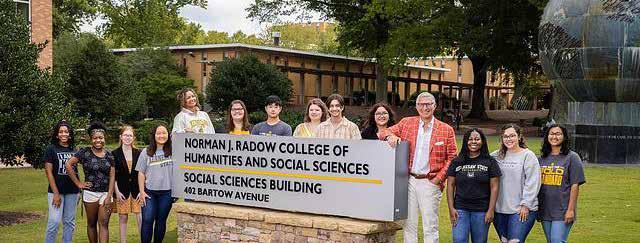

But Leven’s interest in the university was just one example of a long line of accomplishments and philanthropic gifts that Jewish donors have made to the school that has grown exponentially over the past three decades.
The program that Leven’s gift helped to endow is housed in the Coles College of Business, named after Michael Coles, the hard driving entrepreneur who started his career selling men’s clothing in Miami. He founded the Great American Cookie Company at Perimeter Mall in Dunwoody in 1977 and built it into one of the most successful independent food franchising businesses in America. His gift in 1994 was the first seven-figure contribution that the university had ever received.
Coles’ 35-year philanthropic journey, which includes his long-term, dynamic

leadership of the state’s Hillel organization and his pioneering work in the state’s film industry, began with the lessons he says he learned as a Kennesaw trustee and, later, the chair of that governing body.
“I would say that more than anything, I learned how to work in a nonprofit world to create visionary leadership and getting putting people on our
board that would share the vision. I would say that I’ve been very fortunate to have led some very strong nonprofit organizations. And I would say in every single one of them it took the work of the board to do it.”
In 1998, Coles was joined by another philanthropic leader, Norman Radow, a highly successful real estate investor who, like Leven and Coles, had come
from modest means. He was born and raised in Brooklyn before coming to Atlanta and his voice still retains a trace of his New York accent.
It was in the fundraising innovations that he brought to Kennesaw in partnership with Coles, Leven and others that laid the groundwork for Kennesaw’s great leap forward in the opening decades of the 21st century. Under his
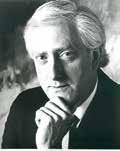
leadership, KSU changed from a commuter school to a school with a large resident student population and a full-fledged center for academic research. The vehicle for that growth, as Radow is quick to point out, has been the privately financed Kennesaw University Foundation, which he chaired for four years.
“The foundation helped build thousands of student beds. We built parking decks, we built a dining hall, a sports park, and a football stadium. We doubled the size of the physical size of the landmass of campus. We developed $600 million of real estate infrastructure.”
To top it off, in 2020, Radow and his wife, Lindy, donated $9 million to Kennesaw’s College of Humanities and Social Sciences, which set a new record for individual giving. The college was renamed in his honor.

Over the years, these major gifts, along with the work done by other Atlanta contributors like Joel Katz, Barry Hyman, Steven Cadranel and Harry Maziar, has helped build Kennesaw State into a major academic powerhouse. Kennesaw president Kathy Schweig expressed the university’s grateful appreciation.

“The support and leadership we have received at Kennesaw State from Norman Radow, Michael Leven, and Michael Coles has been nothing short of transformational. Their generosity has helped make KSU what it is today.”
Working together, these three friends and fellow philanthropists helped Kennesaw grow eight-fold in the last 35 years. It now has 43,000 students, making it the second largest university in Georgia. This year’s freshman class is the largest in the state. ì
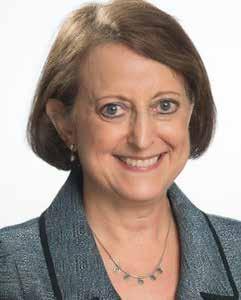 By Marcia Caller Jaffe
By Marcia Caller Jaffe
How do young adults who exist in a swirl of emojis, abbreviations and social media morph into a real world, functioning member of business culture -- as old fashioned as that may seem?
Charleston, S.C., native Sarah Popowski is a Georgia State University professor who does just that in her mandatory course, Business Communication and Professional Development (BCOM 3950).
She said, “I stress to my students that you cannot communicate in the business world like you communicate with friends via text…compared to say, 10 years ago, today’s students are less prepared to enter the business world because they are exposed to less face-to-face communication. Business communication has
changed in the past decade by becoming more casual. I think it’s due to the use of text in business where people use many acronyms. I rarely, if ever, use them...LOL (laugh out loud)...GM (good morning). It’s not that I don’t like them... it’s just not appropriate for business communication.”
For more than a decade, Sarah Popowski has instructed and molded students at the J. Mack College of Business at Georgia State University on how to present themselves to best secure careers or enter advanced degree programs.
In her coursework, Popowski equips students with the communication skills and career advancement strategies needed to enter the professional workplace, as well as applying to graduate or professional school. Summarily, she prepares students to launch their careers and enhance their professionalism.
Most of Popowski’s students, approximately 20, are college juniors. She requires them to attend inperson classes, and her grading is “what’s

earned.”
She said, “The final grade is what a student earns. I do not curve grades. Yes, I do fail students…usually have at least one per semester.”
This course is mandatory to graduate through the School of Business and includes both written and oral communication skills. Cell phones are not allowed while she is lecturing, except where appropriate on group activities or team projects. Students must do presentations and writing skills to show competency.

Two “Sarah-isms” to project students on the path to business success, include:
• It’s not only what you know and who you know, but who knows you.
• Never, ever, under any circumstances lie on your resume.
She said the “Sarah-isms” sound obvious and that she “gives examples of high-level people who did lie on their resumes and lost jobs. I tell my students this on the first day of class; and it is the last thing I tell them at the end of the semester.”
In terms of the effectiveness of the coursework, Popowski has had several students reach back to share success stories...like how learning to do an elevator pitch in class helped with networking and landing a great job.
Popowski has an undergraduate degree in education from the University of South Carolina and a master’s in human resource development from Georgia State. She has credentials as SPHR (Senior Professional Human Resources); and SHRM – SCP (Society for Human Resource Management – Senior Certified.) She was the first human resources professional for the Jewish HomeLife organization, from 20122021, serving as chief human resources officer. Previously, she was director of human resources at the Jewish Federation of Greater Atlanta.
In her HR career, she always utilized a communication tool as the need to hear both sides of a situation and often uses a quote that sums it up, “No matter how flat the pancake, there are always two sides.” ì
1) Plan your communication. A method I teach in the class is AIM (Audience, Information and Message).
2) With regard to No. 1, know your audience and devise a message that will resonate with them.
3) You should spend most of your time planning the message and not delivering it.
4) Do not send an email when you are upset. Draft and save. When you go back to it, the final is hardly ever as intense as the draft.
5) Always err on the side of being more formal when you don’t know your audience well. That includes how you dress if in person.
BONUS TIP -- Parents can help move students along by having more face-toface conversations at home with their children, specifically at times where they cannot be on social media.
TO LIFE AT EVERY LEVEL.
Children’s book author Joe Bottman was flown to Hanoi by the National Vietnamese Bank to discuss making a version of his children’s book, “Peep,” in their language.

Actually, traveling and composing around the world was one of the impetuses that inspired Bottman to write, or “illustrate” the book because it literally has no words.
Born and raised in Chicago, Bottman headed for Italy to study fine art in Florence. There, he discovered, “While I was creating picture books for Italian elementary schools, I realized the power of wordless storytelling. Just like that, ‘Peep’ was born. I continued my studies in Italy studying illustration, design, and sculpture before returning to Northeastern University, in Boston. Within a few months, off I went to the west coast of Ireland and illustrated what would become ‘Peep.’”
Bottman illustrated “Peep” in watercolor and ink. The story is about a little bird and his journey through Ireland. He makes friends with a cute cow and pig duo, but when a weird mishap switches his new friends’ colors, the three are faced with understanding what it means to be different and learn what really matters.

Bottman related this to unfortunate divisions in our complex world. He noted, “In Ireland where humanity is so divided, I saw “Peep” as an opportunity to unite the children of the world by understanding how to communicate through art. The interpretations are endless, based on background, which creates discussions about cultural understandings and the world that children’s books don’t typically have. I wanted something that could be enjoyed by kids everywhere - not limited to one language.” Thus, no words.
Per Bottman, teaching color and diversity are not the easiest of topics. “Peep” is an educational resource that helps make hard conversations a little easier. The narrative explains why “you shouldn’t try to change who you are or what you look like and embrace everyone for who they are - no matter their color.”
Since it doesn’t have any words, a parent can choose the depth of the message to delve into with their child. Bottman continued, “It’s a tool to talk about equality that grows with your child. [The] older they get, the deeper you can discuss it and the more you can choose to take away from it. It was designed to facilitate conversation.”
From his Jewish perspective, he said, “Experiencing antisemitism always made me wonder…who taught someone to think this way? How can anyone hate anyone for their color, race, religion, sex, etc. I think everything stems back to education - so this book is my attempt to give kids, regardless of the views of their culture or family, a chance to rally around the same lesson of equality. A chance to create a world where less kids have to ex-
perience prejudice - whether that is Jewish, Christian, Muslim, Buddhist, atheist, Black, white, or anything else.”
Bottman’s favorite page is the last. The story doesn’t say what color the animals end up - because it doesn’t matter. Every time he reads the story to a child and ends it on that page, they look up at him, and he observes them thinking about what could have happened…wondering what comes next. He loves that
moment because “sometimes the best answers are the ones we don’t have.”
After a career as an illustrator for Wayfair, Bottman, now 28, moved to Atlanta to develop and execute his branding and design business.

To get a copy of “Peep,” visit www. peepbooks.com. There are three options, including a hardcover book starting at $19.99, a hardcover with a plush peep doll, or a bundle option. ì

Marian Goldberg is no stranger to the Atlanta fashion scene. After high profile jobs with Dior, David Yurman, Cartier and, more recently, area marketing director for Saks Fifth Avenue, she thought about mentoring young fashionistas who might not be so keen on archery or sitting around a campfire.
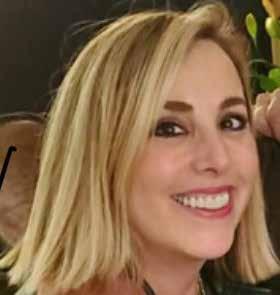
Thus began her execution of a local fashion camp with days filled with field trips, stylizing, meeting with fashion experts in a wide swath of exposure from costuming to wellness, branding and catwalking…and it’s not just for girls!

Goldberg said, “I would have loved fashion camps as a child because I faked (not very convincingly) my way through one season of traditional camp. This year, I decided to put the plan into action. I received a plethora of support and was blown away by the impressive talent and connections who generously agreed to participate.”
Campers are between 10-16 years old, and the camp will cover a comprehensive range of topics, including: lessons from stylists, makeup artists, and yoga instructors; fragrance creation; videos of Paris and Milan Fashion Week; meeting the owner of Click Models and more.
Camp cost is $450 for five days/seven hours per day. The only comparable program is in Los Angeles that costs more than $1,250.
Goldberg is considering modified programs yearround. She said, “We’ve had many requests for an adult version, a ‘Mommy and Me’ version, school break sessions, specific to LGBTQ+ groups, or breaking up the age groups into smaller ranges.”
Goldberg wants parents to think that for the right child, fashion may indeed be a serious career choice. She said, “I don’t have my own children but have dozens of nieces, nephews, and godchildren. To see unconditional support by their parents and role models is the best thing you can give your child. There is no right answer, but following your heart cannot be wrong.”
Fashion runs in the family as her mother studied fashion in New York and was a showroom model for the brand Evan-Picone. She was Marian’s fashion role model, and even worked for her as a merchandiser when Marian was with Christian Dior.
Goldberg grew up in Charlotte and attended the University of Georgia where she studied international business, and then moved to Atlanta to take a position in the financial field. Knowing it was fashion that fueled her, she embarked on her fashion journey initially in sales and headed up a merchandising program in more than a dozen states and Puerto Rico. She then became a national sales manager for Waterford Linens. She switched courses to the retail side and opened the David Yurman Store in Lenox (2004), eventually becoming the area
manager for the Southeast followed by serving as a director for Cartier, before joining Saks. There, she executed more than 500 events and many memorable special experiences.
Goldberg dishes on her own favs: classic designers - McQueen, Dior, Valentino, Givenchy, and, more recently, Sacai, Monse, Dries Van Noten. She often dresses in black, but for evening, she goes for bold jewel tones, red, green, maybe yellow.
She said, “I gravitate towards telling
a story with a beautiful color, print, or asymmetrical cut. In camp, we will discuss high/low fashion and investing in timeless pieces that can be worn forever.”
Last word from Goldberg, “Most people have no idea what all careers are available from merchandise planning to personal stylists. ‘Out-of-the-box’ can be whatever they wish to create in the future. How about a career in AI emphasizing sustainability?”
For more information, email Goldberg at acessorygrl@me.com. ì
Day 1: Retail luxury tours about the DNA of brands like Alexander McQueen, Tom Ford, Dior and focus on icons
Day 2: SCAD tour and lessons from designers and experts in fashion sustainability
Day 3: Styling expertise, personal, editorial, social media and costuming for film/TV
Day 4: Wellness and beauty -- focus on mindfulness, healthy habits, skin care and beauty plus fragrance sampling menu.
Day 5: Creating a fashion show with Click Models and Catwalk Productions as well as casting, music, storytelling
The culmination will be with

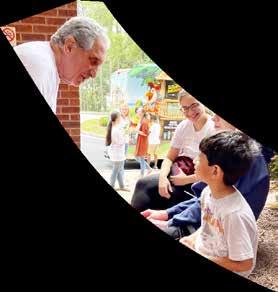


 By Marcia Caller Jaffe
By Marcia Caller Jaffe
When students need that extra boost to form good study habits, write winning essays, and think critically about their education goals, tutor Zahava Feldstein steps up.
A graduate of the Epstein and Weber schools, Feldstein is currently a PhD student in education and Jewish studies at Stanford University. She knows her way around applications as she also completed a master’s degree in religious studies at the University of Chicago Divinity School (2023) and a bachelor’s degree in American studies and psychology at Scripps College (2020) -graduating in three years.

Of her tutoring services, she said, “I teach the writing process as early as ninth grade with the understanding that developing the practices of a deep and critical reader are imperative to learning how to write throughout high school and will serve them in life far beyond.”
When asked about the teachabililty of teens, she advised, “Ask good questions, challenge authority. My father,
a rabbi, taught me that to question and challenge are the foundations of Jewish thought. While Jewish scholars in every generation have looked back to revered authorities for guidance, they have done so with a willingness to interrogate the former’s rationale. Questioning, challenging, refusing blind acceptance—that is the intellectual endeavor for which students must strive. And this precept, when taught as permission to think critically and independently, is what a student needs to truly become a problem solver, whether the challenge manifests in testtaking, time management, essay writing, or succeeding later as a college student.”
Feldstein’s tips on writing for success:
1) Individuate supplemental essays: Get to know the schools you are applying to and create application materials specific to each institution, and responsive to their academic approaches, extracurricular offerings, and institutional identities.

2) Get to know current students, faculty, and the admissions team prior to
applying! The better you know them, the better they can know you.
3) Research common (and less common) majors at each school - especially if you are interested in being awarded a merit scholarship - as these often go to students in specific areas of study based on different needs in different schools.
4) Author a CommonApp essay which narrates a specific story, highlights your unique characteristics, and showcases your creative nonfiction writing abilities. For my CommonApp essay, I wrote about challenging a teacher at an academic summer camp who fell into stereotypes and acted with prejudice towards my Orthodox female campmate.
5) Aim for creativity when crafting school supplemental responses. I was reading back on my own undergraduate application materials and rediscovered the following prompt, “What matters to you and why?”
Feldstein charges a standard fee for preliminary sessions, which covers: her prior review of the student’s materials (transcript, writing sample, list of

extracurriculars), a one-hour discussion gauging the student’s needs and prospects, and list of colleges/universities to consider, alongside itemized application components that are provided following the session. Then, she offers a sliding scale to include students from variant socioeconomic backgrounds and has more learning options.
For more information, reach her at zavifeldstein@gmail.com. ì
I was in Tarnow, Poland, and in front of me were ditches carved for the massacre of 800 children. These victims were forced from their orphanage in 1942 and shot in this forest, Buczyna. I stood beside the remains of two-feet-tall skeletons, heart aching as I envisioned innocent children marched to their deaths and shot through their heads. My classmates chanted a famous prayer in honor of these victims: “Hinei Ma Tov Umanaim,” a song which translates to “how great and sweet it is to sit with my brothers and sisters.”
As a birthday party host, I celebrate with young faces; as a teacher at religious school, I watch confused students try to understand new material; as a nanny, I put infants to sleep with the soft whispers of a picture book. I know the faces of these children, but singing those words, 70 years after such an atrocity, I saw something new: faces were rising from the mass-grave, which was as big as a basketball court, smiling and laughing, clapping for us “Big Kids.” There was so much hope in their faces, but I knew it was inconsequential. An intense responsibility to protect these children arose in me. I wanted to jump up in front of them and shield the Nazi gunfire. I wanted to fight. My duty is to children, and I will enhance their lives in any way I can.
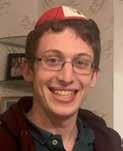
Nina Leff was always going to study in Israel. An Atlanta native currently attending Riverwood International High School, Leff grew up knowing she would follow in her father’s footsteps and spend a semester attending Alexander Muss High School in Israel, Jewish National Fund-USA’s college prep, study abroad in Israel experience and her father’s alma mater.
“He’s been telling me about it my whole life, so it was nothing new,” she said. “I was always going to go; it was never a question!”
And once Leff got to Israel, she had no regrets. “It was the best decision I’ve ever made,” she exclaimed. “I’ve never learned more in my life, and I’ve never wanted to learn more.”
She credits both the professional team and her peers at Muss who supported her desire to learn and achieve. “I had the most amazing Israeli studies teacher, and I made the best friends I’ll ever have,” Leff said. “It was the best experience I could ever ask for.”
Muss is known for its unique blend of traditional classroom learning with an experiential Israel studies program that utilizes the land as a living classroom. The school holds numerous tiyulim (field trips) which are a powerful way for students to learn about Israel in a way that can’t be taught through textbooks or the internet.
For Leff, going rafting in the Golan Heights stood out as a particularly fun and meaningful experience. On the educational side, she recalls their trip to Tzfat as extremely memorable. “Tzfat was an incredible religious learning experience,” she said. “That’s when the whole semester got to connect. It felt very spiritual, and everyone changed for the better.”
Muss has become increasingly popular in the Atlanta community. Over the last two years, more than 20 students have studied abroad at Muss with another 25 teens set to attend over the coming summer.
While the study abroad experience has helped Jewish students in Atlanta create lifelong connections with their fellow Atlantans, they also created friendships with Jewish teens from around the world
and Israel. As Leff explained, “I tried to become friends with every single person there. I think that made me grow, putting myself out there and trying to find a way to connect with everyone.”
Now back in Atlanta, Leff feels transformed from the experience. “It led me to know what I want when I’m older,” she said. “I want to eventually become more in touch with my Judaism. I want to go back to Israel. The people completely changed who I am. They made me a better person.”
Having already convinced her sister to attend Muss in a few years, Leff has some advice for people who are thinking about going.

“Put yourself out there,” she said. “I get texts from so many people, especially ones going on summer programs with Muss, asking ‘how did I make friends?’ and worried they wouldn’t meet people. Yet I tell them that’s the one thing they don’t have to be concerned about! And
go on all of the hikes,” she added with a laugh. “They seem hard in the beginning, but they’re not!”
To learn more about Alexander Muss
High School in Israel, visit amhsi.org or contact Dani Oren, Israel Programs Admissions Director, at doren@jnf.org or 404.236.8990 x852. ì


The Atlanta Jewish Film Festival kicked off its new relationship with the recently refurbished Tara Theatre with a complimentary preview July 18 of the new summer blockbuster, “Oppenheimer.”
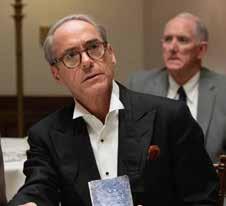
The film was written and directed in masterful style by the veteran Hollywood filmmaker, Christopher Nolan. It chronicles the moral and political struggle faced by the nuclear physicist, J. Robert Oppenheimer, who was instrumental in developing the world’s first atomic weapons during World War ll.
A capacity crowd, motivated in part by the free tickets the AJFF distributed and the massive publicity campaign the film has received in the last month, were welcomed by Kenny Blank, the AJFF’s executive and artistic director.
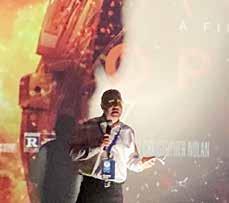
He used the screening to promote next year’s AJFF as something for everyone. Blank pointed out that there is a “misperception” that the AJFF is only for a small part of the community, when, in fact he emphasized it is an event which presents an international line-up with universal themes, that “really speak to all audiences.”
The Tara’s location, with its proximity to a younger urban demographic, is likely to play a significant role in next winter’s festival, which, Blank announced, will run from Feb. 13 to March 7.
But for its scale, star power, and pyrotechnic special effects, "Oppenheimer" is a brilliant example of the kind of film the AJFF has built its reputation upon.

It’s a multi-layered, intricately structured production that follows its highly conflicted central character through his many personal crises. The film chronicles the moral and political struggle of Oppenheimer, as he attempts to come to terms with his pioneering role in the development of the world’s most destructive weapons.
This sensitive and brilliant Jewish scientist is portrayed in a highly nuanced performance by the Irish actor Cillian Murphy, a frequent presence in Nolan’s films. Oppenheimer’s accomplishments led to a burst of worldwide acclaim after the nuclear bombs ended World War II in 1945. That monumental effort was accomplished with some of America’s best scientific minds, including many who were also Jewish. In fact, in the film, Oppenheimer credits Hitler’s antisemitism that drove many great scientists from

Europe and made the A-bomb possible. It was Albert Einstein, for example, who, as early as 1939, wrote a famous letter to President Franklin Roosevelt that urged him to begin a program to develop a weapon based on the fearsome power unleashed by the splitting of the uranium atom.
After his wartime success, Oppenheimer quickly became disillusioned with the massive destructive potential of the new bombs. He campaigned against further research and, in a critical, but disastrous meeting with President Harry Truman in October 1945, he told the American leader of his revulsion at the blood he felt was on his hands. Truman rejected Oppenheimer’s misgivings and later characterized him as a “crybaby.”
His fervent campaign against the new weapons, which he feared would lead to a new arms race with the Soviet Union, put him on a collision course
with another influential Jewish political figure, Robert Strauss, convincingly played by Robert Downey, Jr. It’s one of the strongest performances of Downey’s career.
Strauss, a former Wall Street banker, who was well positioned in Washington’s Republican political establishment, was the first director of the Atomic Energy Agency. The heroic aura that is so apparent in "Oppenheimer" in the first two hours of the film is undermined by the relentless campaign that Strauss sets in motion to destroy Oppenheimer’s reputation in the third and final hour.
The production is based on the book, “American Prometheus: The Triumph and Tragedy of J. Robert Oppenheimer,” by Kai Bird and Martin Jay Sherwin, that won a Pulitzer Prize when it was first published in 2005. The film borrows liberally from the book to describe the socalled Red Scare that contributed to Op-
penheimer’s downfall.
Part of the fear of Communist influence in America was the Soviet Union’s successful program to develop an atomic bomb of their own that was first tested in August 1949.
In 1954, Strauss used Oppenheimer’s support of left-wing political causes and both his wife and brother’s participation in the Communist Party in the 1930s to convince a government committee to refuse to renew Oppenheimer’s security clearance. He was branded a threat to national security and his career was effectively ended.
Nearly a decade later, President Lyndon Johnson, in a gesture seen as helping to rehabilitate his reputation, gave Oppenheimer the Enrico Fermi Presidential Award. It was for his life-long achievement in the field of energy. The award is named after a Nobel Prize winner, who was also an early nuclear pioneer.
Conjuring images of “Saturday Night Live” and wild and crazy “girlie/guys,” Laura Doman, Pamela Gold, Sloane Warren, and Pam King hit the stage running with their passion for being on the edge of creativity in their new class undertaking.
Emmy Award-winning director David Webster, founder of the Whole World Theater, created a new form of fun – “GrooveCats Improv Comedy Show,” based on believable and emotional characters who are experientially involved in their present circumstances. Everything is created on the spot, fueled by audience suggestions and the performers’ quick thinking.
And, of course, there’s some Jewish “schmaltz and pizzazz.”
Doman is an actress, voiceover artist, author, and speaker with credits in film, TV, commercials, corporate industrials, training videos, and print. She also loves bridging the worlds of business and entertainment by coaching non-actors to become more comfortable and charismatic on-camera themselves. She believes that corporate videos and Zoom calls aren’t going away.
She stated, “Acting is living truthfully from moment to moment, and nothing teaches living in the moment like improv. I’ve always enjoyed the unexpected, from calling on clients as a former IT sales exec to the thrill of last-minute cold reads and finding auditions and bookings that have popped into my inbox. The spontaneity, high energy, and bonding between the GrooveCats is especially infectious! The audience can’t help but become part of the experience.”
Doman studied with Second City in Chicago and Atlanta Highwire before discovering the GrooveCats.
Gold is an actor, singer, and dancer who works in theatre, TV, film, commercials, and voiceovers. She appeared on Broadway in “How To Suc-
ceed in Business Without Really Trying” with Matthew Broderick; and “Once Upon a Mattress” with Sarah Jessica Parker; she also toured nationally with “A Chorus Line,” and has performed on regional stages all over the U.S. and in Atlanta. Television credits include “Dynasty,” “Ordinary Joe,” “The Walking Dead,” “The Girl from Plainville,” “Your Worst Nightmare,” as well as several films.
Gold mused, “I was excited to delve into improv to free my creativity and get out of my head onstage. You have to honor and trust your impulses and instincts, and even more importantly, act on them. Laughter is a balm. Coming out of the COVID pandemic — a time defined by fear and isolation — the laughter and connection through improv is something I can’t wait to share with our audiences.”
King taught dance and designed choreography for many years as a theatrical actress, and now teaches public speaking
and professional writing. She laughed and said, “At my first improv class, I met the man that would become my husband. Shortly after we started dating, I stepped away from improv, got married, and had a family. Fast forward 16 years and here I am back at it!” She adds, “It was time to do something a little scary, to break out of normalcy, and, most of all, to see what it felt like to be vulnerable in a space where the goal is laughter.”
The GrooveCats are multi-generational. “This experience with people of all ages and backgrounds truly fosters community and acceptance. Improv pushes me out of my comfort zone. The only way we really live is to do things that scare us a little bit,” King said.

Warren is an actor, writer, improvisor, and voiceover coach whose love of travel has enabled her to master many dialects and accents. She’s worked on screen with
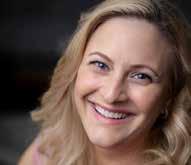



Al Pacino, Laura Linney, and Karl Urban, among others. She explained, “But nothing is as exciting as jumping into the deep end of comedy improv without a float. Your focus is pinpointed on your partner as your raft, and it’s truly the most exhilarating feeling one could have.”
For more than 15 years, Sloane yearned for a place in Marietta where she could fully indulge in her passion for improv comedy. Miraculously, fate intervened when she connected GrooveCats Comedy with David Webster to local arts supporter Colt Chambers who had announced the revitalization of the Alley Stage Theater. The GrooveCats’ theatrical debut was a huge success - a sold-out house and a performance by Sloane in Hebrew! (Well, a prayer anyways!)
The GrooveCats perform at 8 p.m., most Thursdays. Details, classes, and tickets are available at Gro-
ì
“Iwas excited to delve into improv to
freemy creativity and get out of my head onstage. You have to honor and trust your impulses and instincts, and even more importantly, act on them. Laughter is a balm,” said Pamela Gold.

 By Bob Bahr
By Bob Bahr
An innovative and expansive bar room and entertainment space at Pullman Yards in East Atlanta’s Kirkwood neighborhood has become a major attraction since it opened just over six weeks ago. The new facility, AlcoHall, which takes up more than 17,000 square feet, is patterned after the food hall concept, a favorite of developers like Jamestown Properties at its Ponce City Market, and The Works, a Selig project on the West Side of Atlanta.
As its name would suggest, AlcoHall sells an assortment of adult beverages from a series of independently owned leased spaces. The facility where it’s located was once an upholstery and repair shop for the Pullman Rail Car company, whose name still graces the site.
Since opening June 10, Adam Rosenfelt, the owner of Pullman Yards, estimates that 50,000 visitors have sampled the seven brands that have signed on as tenants.
“This project has been fully embraced by the city, the state and the entire Southeast, really.”
To go with the drinks, the thousands of square feet of floor space in the newly remodeled building make it possible for the room to be turned into an entertainment space.

Coming up on Aug. 3-4, there will be a two-hour performance of what’s called the Pullman Pops Orchestra led by threetime Tony Award nominee, and Michael Feinstein’s conductor, Larry Blank. The 45-member ensemble is presenting a Broadway Spectacular with vocals from recent favored show tunes that you can accompany with a drink from the various bars and food from Pullman Yard restaurants.
“This is one of the biggest pop symphony orchestras in the country, Rosenfelt says. “We fly in Broadway singers. This is the third year for these Broadway programs. They are very successful, very popular, really great shows.”
The growing popularity of the new AlcoHall is welcome news to the companies that have signed onto get their products in front of the attractive demographic that Pullman Yards is reaching.
The international Japanese whiskey producer, House of Santory, is celebrating its 100th anniversary this year with a new presence at AlcoHall. Their Pullman Yards opening is part of a $77 million investment in newly revamping distilleries and a newly created marketing campaign
that is scheduled to begin this fall. Other international brands participating in the AlcoHall concept is a South African vineyard, Babylonstoren Winery, and Don Papa Rum, from the Philippines.
There are also a couple of bourbon brands, Short Barrel Bourbon, a local operation from Norcross and Three Clouds, which is owned by singer and songwriter Pat Benatar and her husband.
Rounding out the offerings are drinks from Desert Door, a distilled product made from sotol. That’s a desert plant that is often compared to the agave cactus used in the manufacture of tequila. For beer lovers, there’s Wicked Weed Brewing, from Asheville, N.C.
The 27-acre site on which AlcoHall is located was largely an abandoned industrial area until Rosenfelt and his Pullman Yards and Atomic Entertainment companies redeveloped the property and opened for business in May 2021.
The facility has hosted the North American premiere of the multimedia presentation, The Van Gogh Experience. To celebrate its second-year anniversary, the site welcomed “Jurassic World: The Exhibition” in May of this year. The exhibition, which has numerous locations around the world, is set in Isla Nublar -the home of the fictional island’s most interesting creatures, including a giant Tyrannosaurus Rex and Little Bump from Camp Cretaneous.
In just over two years since its opening, Pullman Yard has attracted a total of 2 million visitors. About 40 percent of them, Rosenfelt says, comes from the Atlanta area; 30 percent are from the metropolitan area, and another 30 percent are regional travelers who have made it there from as far away as northern Florida, eastern Texas, and Louisiana.
The former railroad yard has also been a favorite location for visiting film
and TV crews. It’s been the location for filming of “The Hunger Games,” “Baby Driver,” and “Fast and Furious 5” and an immersive experience of Netflix’s “Stranger Things.”
A network of some of the leading research universities, including Emory University in Atlanta, has created a Science Gallery Atlanta, which has a 9,000 square-foot exhibit about justice. It examines the question of how we live with one another and how those relationships influence the world. It’s part of a multidisciplinary approach to a range of issues that are expected to be examined in the field of public health, biology, and the social sciences.
“What we say is you can come for an AlcoHall event, and you might end up staying for something entirely different,” Rosenfelt says. “We’ve had two U.S. presidents here since we’ve been open. So far, it’s s been a really good run.” ì
ence our home in the B. Mifflin Hood Brick Company building just behind the site; railroad ties -- which reference the history of the BeltLine: and the endangered red wolf -- which speaks to the earlier history of the area. These historical and environmental messages were the reasons we were excited about this design.”
Marcia Caller Jaffe
When Laura Adams married fifth-generation Georgian Andrew Feiler, in lieu of traditional gifts, family and friends conspired to honor the newlywed’s NO GIFT request with public art to be placed near the couple’s home, a stone’s throw from the BeltLine.

Dovetailing with Adams’ and Feiler’s proclivity for civic responsibility, affinity for art and conservation, artists from around the world were asked to submit proposals for the site. The result, recently installed, is Chris Condon’s “Canis Rufus,” depicting the highly endangered red wolf, which once was the largest mammal solely native to the U.S. and freely roamed Georgia.
Fine art photographer, activist, and author Feiler said, “Condon’s proposal was selected because of its three components: bricks -- collected from the neighborhood, which refer-
Adams creates her work out of her Brickworks Gallery art studio on the home’s east wing. She “paints" magnificent wildlife collages out of textured and patterned papers from around the world rather than using traditional paints. The images appear to jump out of glistening reeds, soar, and stun.
See how these community-aware citizens help make Virginia-Highland so “howlingly” special.
Marcia: How did you execute “Canis Rufus”?
Andrew: The surprise wedding present was really a “concept.” It took several years of working with the city to determine who owned the site and then which departments had authorization over the site. No one had ever done this before! City Councilmember Jennifer Ide was instrumental.
Laura: It’s a joy to watch people walk by, stop, or bring flowers as offerings. Many are mesmerized by the sculpture. We have even received thank you notes from neighbors. I like that it’s an accessible piece. Something different appeals to everyone. The wolf forms are so life-like that dogs growl at it!
Marcia: What drew you to the B. Mifflin Hood Brick Company building?
Andrew: While living in Candler Park, we stumbled across this old structure and fell in love with it. We started researching its history and quickly found that we’d been dealt a saint. B. Mifflin Hood was a rare Southern Progressive who was horrified when he found that his brick company competitors participated in the convict leasing system, one of the most egregious practices of the Jim Crow era. It was Hood who led the ultimately successful effort to ban convict leasing in Georgia. It is because of his leadership in that fight that our building is now listed on the National Register of Historic Places.
Marcia: How did you make it a home?
Laura: We hired architect Brian Bell

(BLDGS), to create a plan to convert a rectangular office space and showroom from the 1920s into a comfortable, functional home. Brian was masterful with preserving the architectural details, the flow and light of this old building, and turning it into a space that we love to inhabit. We have added a terraced backyard garden with herbs and summer vegetables mingled with native plants and wildflowers.
Marcia: Your photography has inspired a symphony and is helping to create a new U.S. national historical park. You were named 2022 “Book Photographer of Year” by the Paris Photo Prize. You’ve had museum exhibitions at places like Atlanta’s National Center for Civil and Human Rights and Memphis’s National Civil Rights Museum. You have an exhibition upcoming later 2023 at the Museum of Southern Jewish Experience in New Orleans.
Andrew: I’ve been a serious photographer for most of my life. A dozen years ago, I began to find my voice as a photographer. I had long been active in the nonprofit and political worlds, and I found that my creative voice was an extension of my civic voice. My work today com-
Above: The Feiler/Adams dining room exemplifies the natural light and flow that the couple sought from architect Brian Bell.
Right: Adams created “Chimney Swifts” 2020 which hangs in the living room. The birds are in decline due to overuse of pesticides and loss of habitat, but Laura and Andrew “host” them in the chimney. While resident, the birds consume thousands of mosquitoes daily.

Left: Feiler’s latest book is the story of the partnership between Julius Rosenwald and Booker T. Washington, founding principal of the Tuskegee Institute. In 1912, they launched a program to build almost 5,000 schools for Blacks across the segregated South. The late John Lewis wrote the foreword // Photo by Andrew Feiler
Below: Adams is at work depicting a curious and relatable bear clad in his textured, spiked coat of flowers and geometric patterned papers sitting contentedly in a field of pansies, enjoying the quiet and beautiful human-devoid world.
bines image and story as well as history and contemporary issues.
Marcia: You’re traveling the U.S. speaking about your book, “A Better Life for Their Children: Julius Rosenwald, Booker T. Washington, and the 4,978 Schools that Changed America.” What’s the nexus of it?

Andrew: The partnership between Rosenwald and Washington was one of the earliest collaborations between Jews and Blacks in the cause for civil rights. Between 1912 and 1937, a time when there were few public schools for Blacks, the Rosenwald schools program built 4,978 schools across 15 states and transformed America.
Marcia: For more than 20 years, your work has been shown in galleries, juried exhibitions, and private collections.
Laura: I’m a collage artist concentrating on flora, fauna, and birds. I use textured papers, and exotic patterned papers that I cut and layer using a clear acrylic medium to saturate, blend, and layer the pa-


pers. The result is a “painting” with a three-dimensional effect from all the layering. I use papers from around the world -- Japan, Nepal, Italy, Mexico as my medium. I show my work around the country and am currently in galleries in New York, Charleston, Richmond, Nashville, Beaver Creek, and Lenox, Mass.. I’ve been an invited exhibiting artist at the Southeast Wildlife Exposition Fine Art show in Charleston for the last 11 years. Later this year, I will be working on commission for corporate, hospital, and private clients internationally.

Marcia: You’re into nature.
Laura: We just returned from a birding trip to Michigan’s Upper Peninsula. Later this year, we travel to East Africa and, in 2024, I’m taking birding trips to Panama and Colorado. These trips have and will inspire many of my pieces. My large piece, “Chimney Swifts,” hangs in our living room depicting the swifts swirling into the industrialera chimney of our home. The chimney used to service a boiler system for the building. It’s no longer active, but it’s been the summer home of these aerial insectivores for about 100 years.
Last word…

Andrew: Our friends and family came together to help commission a piece of public art in honor of our marriage. The sculpture is now owned by the City of Atlanta and stands on the BeltLine. Perhaps this example will inspire others to make public art part of milestone moments. ì
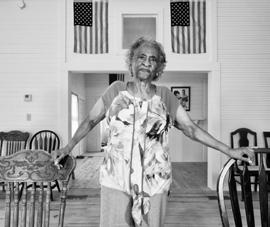
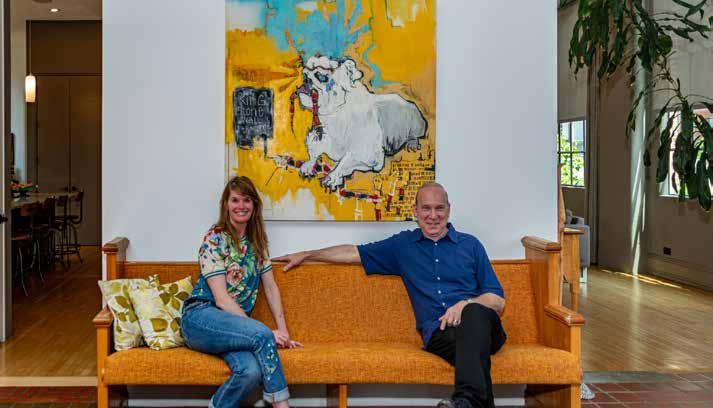 Above: Feiler shot this portrait of Ellie J. Dahmer, widow of slain civil rights leader at a Mississippi Rosenwald school where her husband, Vernon Dahmer Sr., was a student and where later she was a teacher // Photo by Andrew Feiler
Below: Noble Hill School, Bartow County (1923-1955) // Photo by Andrew Feiler
Above: This painting, Rachel Grant’s “Cloud Metaphor,” swirls in the couple’s living room.
Below: Laura and Andrew enjoy the pew they rescued from a small church in Reynoldstown, which they recovered. Above is the “Bulldog” painting by family friend Bradford Moody.
Above: Feiler shot this portrait of Ellie J. Dahmer, widow of slain civil rights leader at a Mississippi Rosenwald school where her husband, Vernon Dahmer Sr., was a student and where later she was a teacher // Photo by Andrew Feiler
Below: Noble Hill School, Bartow County (1923-1955) // Photo by Andrew Feiler
Above: This painting, Rachel Grant’s “Cloud Metaphor,” swirls in the couple’s living room.
Below: Laura and Andrew enjoy the pew they rescued from a small church in Reynoldstown, which they recovered. Above is the “Bulldog” painting by family friend Bradford Moody.
SOJOURN’s Drawing from the Well -12:30 to 1:30 p.m. Everyone is welcome to experience the magic of inclusive community during Drawing from the Well. Drawing from the Well is SOJOURN’s inclusive weekly meetup for LGBTQ+ Jews and allies. Find out more at https://bit.ly/3ZrKEXi.
Interest-Free Loans for Higher Education - until Sept. 30; JELF (Jewish Educational Loan Fund) helps Jewish students by providing interest-free loans for higher education. To qualify, applicants must be a resident of Georgia, Florida, North Carolina, South Carolina or Virginia (excluding metro D.C.), be enrolled full-time in a degree or certificate seeking program, have U.S. citizenship or lawful immigration status, and be able to demonstrate financial need (2022 FAFSA application required). Apply at https://bit. ly/3O50qV7.

THURSDAY, AUGUST 3
Knit and Crochet Group - 1 to 3 p.m. Join Dor Tamid and crochet and knit beanies for premature babies from home. Find out more at https://bit. ly/3VY3R1j.

WEDNESDAY, AUGUST 2
CircleMoms x Temple Sinai x JBaby/ PJ Library - 10 to 11 a.m. CircleMoms provides support and connection for moms in the first 3 months after birth. Through location-specific support groups in cities across the country, CircleMoms is the essential, builtin village every mom needs in the fourth trimester. RSVP at https://bit. ly/3PrGmNE.


Kabbalah and Coffee - 10 to 11 a.m. Discuss, explore, and journey with Intown Jewish Academy through the world of Jewish mystical teaching and learn how to apply these profound teachings to your daily life. This ongoing class probes the esoteric through a unique program of English text-based study. No prior Kabbalistic experience required. Learn more at https://bit. ly/3V3sfiE.
Brain Health Bootcamp - 1 to 3 p.m. If you are recognizing symptoms of cognitive changes or have been diagnosed with mild cognitive impairment, JFCS fun and social class can help you strengthen your mind and body to stay sharp, especially during these times. Sign up by visiting https://bit. ly/3tPwMs3.

MJCCA Book Fest: Kathy Reichs, The Bone Hacker – 7:30 to 9:30 p.m. Join the MJCCA Book Festival and hear author Kathy Reichs, The Bone Hacker speak. One of the very few forensic anthropologists certified by the American Board of Forensic Anthropology. Purchase tickets at https://bit. ly/3rnbNPl.

Jewish Women’s Torah and Tea – 7:45 to 8:45 p.m. Join the Jewish Women’s Circle of Decatur for a weekly discussion on the Parsha and contemporary Jewish issues. Find out more at https:// bit.ly/3T8oR4B.
YJP’s 9th Annual Tu B’av White Party – 7 p.m. Celebrate the end of Summer and the Jewish holiday of love at Young Jewish Professionals Atlanta’s 9th Annual White Party! Dress in your best WHITE summer outfit, coupled or single, love is in the air, and celebrate with other young Jewish professionals all night long. RSVP at https://bit. ly/43ILelj.
Jewish Spirituality and Mysticism – 8 p.m. Chabad North Fulton’s Weekly class on Jewish Spirituality, mysticism and how to apply it to your personal growth in a meaningful way. Taught by Rabbi Hirshy. Register at https://bit. ly/3HDusfN.
Kabbalah Café – 10:15 to 11:30 a.m. Fuel up your week with the transformative teachings of Kabbalah as you enjoy a gourmet hot breakfast and coffee bar. You’ll study text-based spiritual wisdom that gives you practical guidance to living a healthy and empowered life. Join Beth Tefillah by visiting https://bit.ly/3Ak2BfX.


Torah Reading: Eikev
Friday, August 4, Av 17, 5783 Light Candles at 8:17 PM
Saturday, August 5, Av 18, 5783 Shabbat Ends 9:14 PM
Torah Reading: Re’eh
Friday, August 11, Av 24, 5783 Light Candles at 8:10 PM
Saturday, August 12, Av 25, 5783 Shabbat Ends 9:07 PM
SOJOURN’s Drawing from the Well -12:30 to 1:30 p.m. Everyone is welcome to experience the magic of inclusive community during Drawing from the Well. Drawing from the Well is SOJOURN’s inclusive weekly meetup for LGBTQ+ Jews and allies. Find out more at https://bit.ly/3ZrKEXi.
Jeff’s Place Café – 8 a.m. to 12 p.m. Need a place to host your Monday-morning business meeting? Looking to meet a friend for breakfast and coffee? Craving some bagels and lox before heading into the office? Come to Chabad Intown and find out more at https:// bit.ly/3IRgve6.
CircleMoms x Temple Sinai x JBaby/ PJ Library - 10 to 11 a.m. CircleMoms provides support and connection for moms in the first 3 months after birth. Through location-specific support groups in cities across the country, CircleMoms is the essential, builtin village every mom needs in the fourth trimester. RSVP at https://bit. ly/3PrGmNE.

Significant Others of Addicts Support Group – 12:30 to 1:30 p.m. Join Sally Anderson, MS, LPC from JCFS for a weekly free support group for spouses, partners and/or significant others of those struggling with addiction. Learn more at https://bit.ly/3hqghQs.
Brain Health Bootcamp - 1 to 3 p.m. If you are recognizing symptoms of cognitive changes or have been diagnosed with mild cognitive impairment, JFCS fun and social class can help you strengthen your mind and body to stay sharp, especially during these times. Sign up by visiting https://bit. ly/3tPwMs3.

Jewish Women’s Torah and Tea – 7:45 to 8:45 p.m. Join the Jewish Women’s Circle of Decatur for a weekly discussion on the Parsha and contemporary Jewish issues. Find out more at https:// bit.ly/3T8oR4B.

Trybal South - In the Peach State, the people are as warm as the weather and Southern hospitality greets you at the camp gate. Wineries and gentle peaks line the roads to our host camp, nestled in a bucolic valley at the foothills of the Blue Ridge Mountains. Launch your friends sky-high on the blob, zipline across the lake, test your grit on the world’s largest ninja warrior course, make your mark at archery tie-dye, or just chill by the lake. We’ll fuel up for the day’s adventures with home-cooked southern meals and savor nightly campfires with a gourmet s’mores bar. From sprawling athletic fields to a vibrant art center, an incredible aerial ropes course to dozens of electives, there are endless ways to explore, relax, and connect with new friends. So, y’all ready for camp? Then start packing your bags, because it’s waiting for you right here in the southern countryside! Register at https://bit.ly/3O6lF99.

Kabbalah and Coffee - 10 to 11 a.m. Discuss, explore, and journey with Intown Jewish Academy through the world of Jewish mystical teaching and learn how to apply these profound teachings to your daily life. This ongoing class probes the esoteric through a unique program of English text-based study. No prior Kabbalistic experience required. Learn more at https://bit. ly/3V3sfiE.
Kabbalah Café – 10:15 to 11:30 a.m. Fuel up your week with the transformative teachings of Kabbalah as you enjoy a gourmet hot breakfast and coffee bar. You’ll study text-based spiritual wisdom that gives you practical guidance to living a healthy and empowered life. Join Beth Tefillah by visiting https://bit.ly/3Ak2BfX.
Jewish Spirituality and Mysticism – 8 p.m. Chabad North Fulton’s Weekly class on Jewish Spirituality, mysticism and how to apply it to your personal growth in a meaningful way. Taught by Rabbi Hirshy. Register at https://bit. ly/3HDusfN.

Hadassah Ketura Pool Party - 4 to 7 p.m. Have fun and enjoy socializing with Hadassah Greater Atlanta’s Ketura Group for an afternoon of good food and good friends. Pizza, beverages, and dessert provided - your own favorite pareve or dairy side dish is welcomed. Register at https://hadassahhub.wufoo.com/forms/q1knvk9y1058boc/

Jeff’s Place Café – 8 a.m. to 12 p.m. Need a place to host your Monday-morning business meeting? Looking to meet a friend for breakfast and coffee? Craving some bagels and lox before heading into the office? Come to Chabad Intown and find out more at https:// bit.ly/3IRgve6.

I got very excited when I saw a big bag of shishito peppers in the produce section of my local supermarket. Once Chana Rivky, our photographer, easily found them in Boro Park, we were good to go. When my help saw me preparing them, she laughed, “Those are not hot!” The truth is, although shishitos are a more mild pepper, for American taste buds they have just the right kick! And sometimes you’ll get one that’s a little hotter than the rest. Those are a nice surprise. When eating shishitos, bite off the pepper and discard the stem. Feel free to cut the oil and honey in half if you would like to enjoy these as a lowercalorie side (or without any glaze at all!).
Ingredients
shishito peppers
salt, for sprinkling
1 tablespoon fresh minced ginger (or 3 cubes Gefen Frozen Ginger)
2 tablespoons Gefen Soy Sauce
2 tablespoons Gefen Sesame Oil
2 tablespoons honey
coarse black pepper, to taste
1 tablespoon sesame seeds
crushed red pepper, optional
Directions
1. Heat a large sauté pan over high heat until hot. Spray with nonstick cooking spray (you can shut the heat for a moment for safety, if desired).

2. Add one layer of peppers (don’t overcrowd; you will need to cook them in two to three batches), sprinkle with salt, and cook until blistered (time will depend on the strength of your fire), flipping halfway through.
3. Meanwhile, in a small bowl, whisk together ginger, soy sauce, sesame oil and honey.
4. When all peppers have been cooked, lower heat, return all peppers to pan, add sauce, and stir to coat the peppers. Cook for one additional minute.
5. Sprinkle with sesame seeds and crushed red pepper, only if additional heat is desired.
Recipe by Victoria
Source: Kosher.com
Dwek
Sam meets his friend, Moshe, in the mall.
“Hi, Moshe, I haven’t seen you for some months. So, nu? How is the company doing that you set up with Maurice last year?
“Well, as I told you, I put up the money and Maurice put in his business experience. But things have changed a bit since then.”
“What do you mean?” Sam asks.
“Now Maurice has the money and I have the business experience.”


n. The act of being duped and cheated by a financial transaction on the internet.
“Poor Aunt Ruthy. The first time she made an order online, she was a victim of electroshvindl.”
This one is no joke, as anyone who has ordered $15 gloves from an internet retailer and had their credit card charged an additional $45 for shipping and handling will attest.
From the Yiddish shvindl, meaning “scam.”

ACROSS
1. *Star of David item
5. Short punches
9. *Garden spot
14. Fleming, Holm, and Smith
15. School with the most NCAA basketball titles
16. ___ Adumim
17. *Animal that’s cute, furry, chubby, and treif
19. Buc Tom, once
20. Talented Ma
21. “Her ways ___ ways of pleasantness” (Prov. 3:17)
22. Accumulate, as wealth
26. *There’s one for Rabin in Tel Aviv
31. *Leah and Rachel
34. Baseball rally killers, briefly
35. Longhorn’s lament?
36. CREF’s partner
37. Words with shake or break
39. Engaging in cyberchat, informally

41. Jewish down time?...or another title for this puzzle
44. Bad vibration?
46. Common laborer
47. Recipe abbreviations
50. PC bookmark
51. Word from a heckler
53. *They’re certainly not rabbis?
55. *Bibi Netanyahu and Naftali Bennett, e.g.
58. “Me too”
59. Subway scurrier
60. Abba of Israel

63. Pale violet
66. *Marathon or stone
71. Speak from the pulpit
72. Hara preceder
73. One way to run
74. *It always proceeds a bris
75. Falcons quarterback Ryan
76. What many Jews do at the end of 41-Across
1. Some might eat one on Tu B’Shvat
2. “Seinfeld” co-creator nickname
3. It begins 1 enero
4. Sch. with a campus in Atlanta
5. Sport where Israel often excels
6. How some feel the day after a big workout
7. “The Producers” role
8. Downward bend
9. Food for Zeus
10. Way less common
11. Cousin of 35-Across?
12. Like jokes you’ve heard
13. Luke (sorta) trained her
18. Org. at 11 Wall St.
21. It pumps up the volume
22. 3 oz., e.g.
23. First person in France?
24. How the Leaning Tower of Pisa stands
25. Top Iranians, once
27. “___ Tomorrow” (Tom Cruise sci-fi flick)
28. “My aim was off”
29. Get an ___ (ace)
30. Cabin material
32. Showed fear, in a way
33. Like loafers
38. Tel Aviv to Tiberias Dir.
40. Legendary tales
42. Warm greeter
43. Genetic “blueprint”
44. 4x4, frequently
45. Earlier, in a poem
48. Career athlete
49. Govt. funds for the disabled
52. Meal often eaten for breakfast?
54. Gets less white
56. Inspiration for poets
57. “Peace out”
61. Rabbi Sacks was one
62. Dina, to Ephraim
63. 39-Across chuckle
64. Part of a pension plan, briefly
65. Place to examine 43-Down
66. Jelly by another name
67. 1980s sitcom with a furry lead
68. Letters on Anaheim scoreboards
69. Creatures in 27-Down, for short
70. Pete Alonso, for one

Dr. Marlene Bondy Appley of Chapel Hill, N.C., passed away peacefully at home with her family on July 8. At 98, she lived a vibrant and active life. Born in Czechoslovakia, her family eluded Hitler and fled to America. Living in Brooklyn, she joined Hashomer Hatzair, a Zionist youth group, building friendships that lasted a lifetime.

Marlene made Aliyah to the newly created State of Israel in 1948 and helped found Kibbutz Sasa. There, she married George Appley and their first child, Abner, was born. Always a gifted student, she returned to college after the birth of two more children, Elizabeth and Noah, earning a PhD in anatomy and physiology at the University of Oklahoma Medical School. She went on to teach at SUNY Brockport, Marymount Manhattan College, Georgia State University, and the University of the Pacific, where she earned tenure. Settling in Chapel Hill, she continued teaching until age 87. Marlene inspired legions of enthusiastic students who adored her and were mesmerized by her brilliant lectures, her humor, and her charm.
Marlene had a zest for adventure, world travel, art, and music, and was a gifted storyteller with an infectious laugh and a beautiful smile. She was a lifelong swimmer, hiker, and skier. She loved her family and was a wonderful mother, wife, aunt, sister, and friend. She was proud of her children and grandchildren, was a constant support, and delighted in their successes. After a storybook romance, she married a renowned physicist, Dr. J. Ross Macdonald, when she was 91 and he was 93, and they shared many happy years together.
Marlene is survived by her husband, Ross, her son, Noah, and his partner, Naresia Pauly, who dedicated himself to helping her and Ross maintain their healthy and independent lifestyle, her daughter Elizabeth Appley (Sandy Epstein), and grandsons, Benjamin and Joseph (Danielle). She was predeceased by her beloved son, Abner.
Graveside services were held at Greenwood Cemetery on July 12 with Rabbi Lauren Henderson of Congregation Or Hadash, with a later memorial service to be held in Chapel Hill. Donations in her memory are invited to Hadassah Hospital. Arrangements by Dressler’s Jewish Funeral Care, 770-451-4999.



Joel Alan Butler, 84, of Atlanta, Ga., passed away on July 8, 2023. He was born on May 22, 1939, in Atlanta. Joel was a beloved father, grandfather, brother, uncle, son, husband, and friend.
Joel was known for his perfectionism and do-ityourself attitude. He was a hardworking and generous individual, dedicated to his family. Joel was a longtime supporter of charitable organizations such as the AntiDefamation League, The William Breman Jewish Home, and Friends of the IDF. He had a passion for gadgets and “state-of-the-art” technology and enjoyed performing random acts of kindness.
In his free time, Joel indulged in his love for fashion and flair. He was a dog lover, car enthusiast, Atlanta Braves fan, and connoisseur of good food and fine service. Joel took great pleasure in engaging in DIY home improvement projects for himself, family, and friends - including electrical, plumbing, and appliance repair.

Joel had an illustrious career as a financial advisor for 54 years. He worked at Dominick & Dominick, Lehman Brothers (where he worked for over 35 years), and Oppenheimer & Co. Throughout his career, Joel was consistently recognized as a top producer, leader, and mentor. Upon retirement in 2015, Joel remained an active investor in the stock market and took pleasure in “watching the market” on CNBC.

He is survived by his sons, Scott (married to Jane) and Andy (married to Nancy), and his grandchildren, Jennifer Bernstien (William), Amy, Emily, Rachel, Jonah, and Aaron. Joel is also survived by his sister, Frances Kohn, and former spouses, Eleanor Schwartz, and Sissy Evans. He was preceded in death by his parents, Julia and Jacob Butler, and brothers-in-law Sonny Goodman and Herbert Kohn.
A service to honor Joel’s life was held at Temple Sinai in Sandy Springs at 11 a.m. on Monday, July 10, 2023. The interment was held at Arlington Cemetery, with only immediate family in attendance.

In lieu of flowers, contributions can be made to the Anti-Defamation League (ADL), The William Breman Jewish Home, Friends of the IDF or a charity of your choice in Joel’s memory.
Joel Butler will be deeply missed by all who knew and loved him. May his memory be a blessing. Arrangements by Dressler’s Jewish Funeral Care, 770-451-4999.
Sam Draluck passed away on July 1, 2023, just shy of his 98th birthday. Born July 31, 1925, in Hamilton, Ontario, Canada, Sam was the oldest son of Rose Glustrom Draluck and Norman Draluck. They immigrated to Atlanta where, in 1952, he met and married an Atlanta native, Harriet Rosenbaum, daughter of Sarah Pazol Rosenbaum and Louis Rosenbaum, and became a prominent local businessperson.
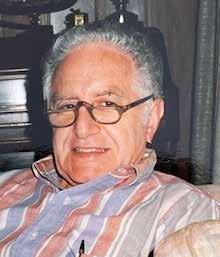
He is survived by his wife of almost 71 years, Harriet, children, Marci (Howard), Ronny (Bonnie), Merrill, and Jonathan (Oren); grandchildren, Dov (Alondra), Noah, and Louie (Goldie) Pine; Mark (Abby) and Ross (Hillary)

Draluck; Doran and Adon Draluck; and Shiri and Yannai
Shamay-Draluck; great-grandchildren, Micah, Margo, Penelope, Marion and, born last month, namesake, Sammy; brother, Marvin (Barbara) and sister-in-law, Sharon Draluck; and numerous nieces, nephews and cousins. He was predeceased by his parents, brother, Maurice, and sister- and brother-in-law, Esther Rosenbaum Buchsbaum and Aaron Buchsbaum.
His parents, Rose and Norman, were Ukrainian immigrants who met in Bucharest, Romania, where they had been sent by their families to find work. They departed from the Constantia port to Canada. Shortly thereafter, Sam was born and given the name, Shimon. As a teenager, when not caring for his baby brother, Marvin, or skating on Ontario’s frozen lakes, he and Maurice would ride the train to Toronto where they hung out at the JCC. His father was a talented tailor and craftsman who began a fur business. But the family also attributed its success (and their well-being) to the savvy that Sam brought to bear.
When he was a single young man, his family moved to be near his mother’s cousins in warmer Atlanta. Sam immersed himself in the community. He helped at his father’s grocery store on Piedmont and Auburn Avenues. He connected with other Yiddish speakers and newcomers. To develop a social and professional network, he got himself sponsored to join the Progressive Club on Techwood Avenue. He cultivated local business relationships, from Sig Samuels dry cleaners, where he was a customer nearly his entire life, and Callaway Motors in Decatur, to an array of trusted associates and counterparts. And he took dance lessons from one of the prominent entertainers at Atlanta’s famous African American night club, the Royal Peacock.
Sam loved his life with Harriet. Through the years they enjoyed extensive travel, friends, and music. For decades, they participated in a monthly gourmet group, dressing up and cooking up delicacies of other cultures and geographies. They got accustomed to overseas travel as it became vogue, traversing Europe both with tour groups and in rental cars, and visiting Asia, Australia, and New Zealand. In their numerous trips to Israel, he had a chance to meet long-lost first cousins from his considerable ancestry who had immigrated from former Soviet countries.
On each journey, he struck up conversations and bonded with locals as was his way. As a result, he would come back full of fun, little-known cultural facts. And as a connoisseur, wherever in the world he went, he would sample his reliable and safe entree – fresh salmon.

He appreciated classical music and opera and was a decades-long season ticket holder of the Atlanta Symphony Orchestra. Together with Harriet, as founders of the original Ahavath Achim Synagogue Cultural Arts Committee and co-chairs for over 25 years, they were able to chart out a musical program of their own, bringing talent to play chamber music. Sam mingled with the musicians and took pride in managing the stage door.
His passion became real estate. In 1953, while taking business courses at Georgia State University, he decided to sit for the agent licensing test on a whim and, in 1957, he acquired his broker’s license as well. As president of Draluck Realty Company, he built a reputation as a tenacious, creative, and honest proprietor over a 60-plus year career. After decades of accolades in the Atlanta Board of Real Estate’s Million Dollar Club, his accomplishments were crowned on receipt of the Silver Phoenix Award by the Atlanta Commercial Board of Realtors.
His personable approach and perseverance in real estate enabled him to fashion the most complicated transactions, navigating celebrities and stalwarts sometimes over years to get to closing. Sam called himself a matchmaker, as he enjoyed putting the buyers and sellers into romance situations. He was adept at dividing multi-unit dwellings into manageable and sellable income properties, doing so from Vine City to Roswell Road. Although his office was on West Peachtree Street for many years, he often con-
ducted business in the field, unreservedly driving to meet up with folks wherever they were in the metro area. With deals always in the pipeline, he stuck it out night and day, and especially during tough times, to make the most for his business and family.


Real estate was entwined in every part of his life. The phone rang off the hook during family dinner time from those who wanted to catch him, their names indelible among giggling children at the table. One client gave him a steer. For his 90th birthday, party guests attributed their past flirtation in commercial real estate to the inspiration they drew from Sam. He mentored Merrill and Marci. He organized business lunches regularly. He developed a reputation in the Progressive Club’s men’s health club, paper and plates in hand, offering real estate in the steam room and sitz bath. And several years into his career, at the behest of a client who sought his pastor’s blessing, he met Dr. Martin Luther King Jr. The next Sunday from the pulpit of Ebenezer Baptist Church before his entire congregation, Dr. King recommended doing business with Sam Draluck.
Sam scarcely realized he retired. He had a banner year in his 80s and vacated his last office in Buckhead only after the building was slated for demolition, but continued to work the phones as long as he could, looking for leads that could satisfy his investors’ needs. He remained in his element – meeting and connecting with people – for almost 20 years as an active exercise class participant at the Piedmont Fitness Center. He loved the bike and as the oldest and most tenured there, was quite popular, pedaling until just a few weeks ago.
Sam felt most blessed with his loving family and the warm home that he and Harriet created. He always took a keen interest in his children’s pursuits, offering cautious advice when he could. He enjoyed spending time with his grandchildren and greatgrandchildren who affectionately called him, “Saba.” His face lit up on Shabbat and holidays as the grandchildren davened and led in song. He will be sorely missed. The funeral was at Greenwood Cemetery. In lieu of flowers, contributions can be made to a charity of your choice. Dressler’s Jewish Funeral Care, 770.451.4999
Dr. Larry Ivan Frank, 79, born on Aug. 25, 1943, and raised in Houston, Texas, died on July 11, 2023, in Atlanta, Ga., of sepsis and heart failure. He is preceded in death by his parents, Minnie and Max Frank, younger sister, Marilyn Marks, and older brother, Dr. Stuart Frank. He is survived by his loving wife of 54 years, Judy (Framer), and two daughters, Stephanie Lambert (son-in-law, Ryan Lambert, granddaughters, Riley and Emerson) and Amy Frank (Jon Bradie).
As a boy Larry loved scouting and had a menagerie of species as pets. He attended Tulane University and was in Alpha Epsilon Pi fraternity. Following graduation from Tulane Medical School, he became a Lt. Commander in the U.S. Navy in California. He completed his urology residency in New York, N.Y. He practiced urology first in Dallas, Texas, and then in Wichita, Kan., from 1997 until he retired at age 72 from the VA Hospital. He loved sailing, wood working, “playing” on the computer, and animals.
A graveside funeral was held on July 13, 2023, at 2:00 p.m. at Arlington Memorial Park, 201 Mt. Vernon Hwy NW, Sandy Springs, GA 30328. In lieu of flowers, donations may be made in his memory to your favorite charity. Arrangements by Dressler’s Jewish Funeral Care 770-451-4999.
Joanie Gaines, 72, passed away on Monday, July 10, 2023. She was preceded in death by her parents, Peggy Kahn Gaines and Harold Gaines, and her older brother, Rick Gaines. She is survived by her stepmother, Kathy Gaines, and her brother, Don Gaines, both of Marietta, and her sister and brother-in-law and their children, Sally and David Moorhead, and Ryan and Madison Moorhead, of Rockville, Md. Joanie was a native Atlantan, who attended Dykes High School where she was very active in sports. She enjoyed travel, especially to Italy, cooking, watching football and spending time with her cat, Holly.

Services were held graveside at Crest Lawn Memorial Park on Tuesday, July 18 at 10:00 am. Arrangements by Dressler’s Jewish Funeral Care, 770-451-4999.
Inge Marx Robbins died peacefully at home with her two devoted daughters by her side on July 23, 2023. Inge was born in Stuttgart, Germany, on Jan. 16, 1929. She narrowly escaped from Nazi Germany with her parents and younger brother, Albert, on Nov. 2, 1938, one week before Kristallnacht.
Leaving behind her beloved grandparents and many other close family members who perished in the Holocaust, the Marx family settled in Little Rock, Ark, where Inge quickly learned English and began her pattern of excelling in school. She took her first solo train trip to La Plume, Penn., where she attended Keystone Jr. College as one of the only southerners enrolled. She embraced college and a lifelong passion for learning. She was popular, joined many clubs, and enjoyed playing bridge and knitting intricate argyle socks in her spare time.
After earning her degree, Inge joined her family in Atlanta, where her father continued his career in the paper business. She rode a streetcar daily to Sears, Roebuck and Co. located in what is now Ponce City Market, where she was the secretary for a senior executive.
In 1957, she met the charming and handsome George Daniel Robbins, who soon would become her beloved husband of 51 years and a day. They named their first home at the E. Wesley Apartments, “The Robbins Nest,” and soon after built a house on Canterbury Road near Lenox Square, where they started their family. Inge and George were charter members of Temple Sinai, where she devoted countless hours to volunteering and attended weekly study groups for decades.
A season ticket holder to the Atlanta Symphony for 40 years, Inge enjoyed classical music, traveling around the world, and working at Piedmont National Corp., the family business founded by her father, Hugh Marx, in 1950. Most of all, Inge loved her family and was a tireless supporter of her children and grandchildren’s endeavors and achievements, always marking special occasions with a family dinner or lunch at the Swan Coach House.
A walking encyclopedia, Inge knew something about everything. She held herself and others to a high standard. She was warm, witty, smart as hell, and a joy to be around. Proper, coifed and well put together yet never showy, she was the eternal optimist and always willing to help. Substance is what mattered, and she had loads of it.
Twenty years ago, Inge found in her attic a box of letters written in old German script on onion skin paper. These letters were sent from her grandparents in Germany to her parents in Little Rock between 1938 and 1942. They chronicled the unsuccessful attempts made by Inge’s parents to help them escape Nazi Germany by sponsoring them in America. Inge embarked on a meaningful project, and along with her brother, Albert, had the letters translated to English and created 10 volumes of books detailing the harrowing story as it unfolded. The large collection of original letters and accompanying photos and memorabilia was recently donated to the U.S. Holocaust Memorial Museum in Washington, D.C., and is one of the most detailed collections of its kind.
Inge will be joining other loved ones who predeceased her, including her parents, Hugh and Paula Marx, and her husband, George Robbins. Survivors include her daughter and son-in-law, Allison (Alli) and Mitch Allen and their children, Heather (Matt) Bernes, Amanda (Colin) Scott, and Jared; her daughter and son-in-law, Carolyn and Nathan Wallace and their children, Miles and Cleo; her brother and sister-in-law, Albert and Jeanie Marx; her great-grandchildren, Jackson, Holden and Austin; and several nieces, nephews and cousins.
Following a private burial at Crest Lawn Memorial Park, a service honoring Inge’s life was held on Tuesday, July 25 at Temple Sinai (5645 Dupree Drive NW, Atlanta 30327).
Memorial contributions may be made to the George and Inge Robbins Cultural Enrichment Fund at Temple Sinai, the Atlanta Symphony Orchestra, or a charity of your choice. Arrangements by Dressler’s Jewish Funeral Care, 770-451-4999.



Lawrence “Larry” Salba, 83, of Sandy Springs, Ga., died July 20, 2023. He is survived by his son and daughterin-law, Benjamin, and Rachel Salba; daughter and son-inlaw, Leslie and Craig Garthwaite; sister and brother-inlaw, Barbara and Chuck Taubman; grandchildren, Elias Matan Salba, Gabriel Phillip Salba, Saul Ethan Garthwaite, and Evelyn Rose Garthwaite; many other loving family members and friends. He is preceded in death by his loving wife, Pamela Salba; parents, Elias H. Salba and Stella K. Salba.
Service was held at Beth Israel Cemetery, Woodbridge, N.J. on Sunday July 23, with Shiva following. Donations may be made to a charity that promotes literacy and reading or any charity of your choice. Dressler’s Jewish Funeral Care 770-451-4999.

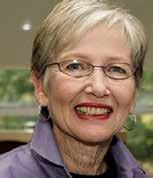
Alice Shapiro, 79, of Atlanta, died early Friday morning on July 14, 2023. She was a loving mother and grandmother, a former classroom teacher, and a lifelong activist in the Jewish community. Alice grew up in Columbus, Ga., enjoyed summers at Camp Ramah, and later attended Case Western Reserve University in Cleveland, Ohio, where she majored in English.
For decades, she worked as vice president of her family business, Singer & Company, while raising three young children as a single parent. She later served as chair of the board of advisors of Weinstein Hospice, as well as a board member of The Epstein School (which her parents, Sol and Ruth Singer, helped found), and as a steadfast volunteer at the William Breman Jewish Home, where she served as the head of the Women’s Auxiliary and helped run the gift shop.
Her passions included needlepoint, cooking delicious meals for family gatherings, walking with friends, reading, enjoying games of mahjong, vacationing with family, and traveling the world with her late husband, Dr. Terry Shapiro, to whom she was married for 25 wonderful years. She was adored as a generous person who gave her time, energy, love, and resources to her family and to everyone around her.
Alice is predeceased by her sister, Sharon, and brother-in-law, Neil Norry of Rochester, and parents, Sol and Ruth Singer of Atlanta. She leaves behind her brother, Eric Singer (Eileen Sherman) of Atlanta, children, David Pinsky of Athens, Dina Pinsky (Mikael Elsila) of Philadelphia, and Mark Pinsky (Melissa) of Marietta, and her grandchildren, Sol and Ilan Elsila and Andrew and Joshua Pinsky, plus many nieces, nephews, cousins, and other loving family.
Donations can be made to Weinstein Hospice, the William Breman Jewish Home, and The Epstein School. Services were held at 1 p.m. on Sunday, July 16, 2023, at Dressler’s Funeral Home followed by a burial at Arlington Memorial Park with her nephew, Rabbi Hillel Norry, officiating. Arrangements by Dressler’s Jewish Funeral Care, 770-451-4999.
David Tallman of Austell, Ga., passed away this week. David was born in Chicago in 1964 and grew up in St. Louis before settling in the Atlanta area after a few years in Florida. His passion and talent for cooking became his career as he moved through the restaurant and food service industry before becoming a catering chef for many years.
He is survived by his mother, Rebecca (Bobbi) Levin, sister, Marcia (Gale) Armfield and brothers, Scotty and Lee (Nica) Tallman, David’s aunt and uncle, Janet and Richard Mintzer, and many cousins who will miss his humor, wit and gentle nature greatly.


He was predeceased by his father Allen Tallman, paternal grandparents, Ann and William, and maternal grandparents, Bernice and William Levin. He left behind his many nieces and nephews which were such an important and special part of his life. We are overwhelmed by sadness and shock with his sudden and much too early passing but take comfort with the memories of his life which were filled with so much love. Donations to BestFriends.org to honor David’s lifetime love of animals. Funeral services graveside at Greenwood Cemetery. A visitation to share love and memories of David followed.
Obituaries in the AJT are written and paid for by the families; contact Editor and Managing Publisher Kaylene Ladinsky at kaylene@atljewishtimes.com or 404-8832130, ext. 100, for details about submission, rates and payments. Death notices, which provide basic details, are free and run as space is available; send submissions to editor@atljewishtimes.com.








You’ll have to go up the hill by yourself. I can’t do this again.” At my tender age, my father gave me confidence that I could do something better than my father. Of course, that is a 6-year-old’s mental conversation, but that confidence helped a very shy young boy, and that confidence is what I have passed on to my children.
Allen H. LipisThe Bottom Line
My father died more than 50 years ago and still I recall the stories he told me and the advice he gave me. His picture is with me on my dresser at home when I was 10 years old and my sister 7 years old. That picture reminds me of him every day. Here is but a sample of what he taught me.
When I was about 6 years old, I lived in Connecticut, and during a snowy, cold winter I went sled riding down a very large hill for several hundred yards. One day, my father joined me on the hill, and on my small sled we flew down the hill with me on top of my father. It was breathtaking and I insisted on going back up the hill for another ride. My father said to me, “The hill is too much for me. You are better at this than I am.
The other day at lunch, we had a discussion about security for our homes. We have a security system, as do other families in our neighborhood, but it reminded me of what my father said about his home that was not nearly as nice as the ones in our neighborhood. He said, “I don’t expect a burglar to break into my home, and if he did, he won’t find anything of value. When he’s done, he will probably leave me $5.” I laugh every time I tell that story for it reminds me of the optimistic spirit my father had about life. I try not to worry about things that are unimportant.
My father worked for U.S. Bronze Sign Company, and he would install the yahrzeit plaques in synagogues and bronze signs outside a bank for the let-

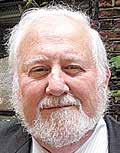
ters of the banks. One time, without any help, he fell off a ladder and broke his pelvis and shattered the bones in his left wrist. He was laid up in a hospital for weeks and never complained. After he recovered almost completely, for the rest of his life he never felt regret about what happened. He merely said it was his fault for not having a helper to support his ladder, and he lived and accepted his mistake. He just moved on. Years later, he settled his monthly disability insurance for a lump sum and it was enough to buy his one and only home. He saw his accident as an event that had a positive result. When something bad happens, it might just turn out to be more valuable down the road than you think.
My father was always available to drive someone who needed a ride to go somewhere, or to take my mother wherever she needed to go. My mother never drove, and my father never said “no” to these requests. It taught me to do the same for my family.
One time on a Sunday, my family took an hour subway ride to Central Park
in Manhattan. My father was wearing a suit and tie, nice shoes, and his watch. As we walked past a small pond, I saw a woman with her very young child near the edge of the pond. The young boy slipped and fell into the pond and could not swim. The woman did not move to help her son and only yelled, “Save my boy. Save my boy!” There was no one else around, so, without thinking, my father jumped into the pond up to his chest and hauled the boy to safety. He didn’t ask the woman for anything, although she offered to pay to dry clean his clothes. He went home in his wet clothes, and from that day on my father was my hero, and he remains my hero still. He taught me that if there are no men around, be that man.
I was in shul this Shabbos, and I was given an Aliyah because my father’s yahrzeit occurs soon. When someone asked me about it, we both remarked that the memory of our fathers is as if they were here a few days ago. May you feel that way about a loved one no longer with you. ì








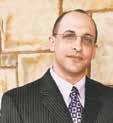























Discover surprisingly slow ways animals survive in a fast-paced world. See Live Animals!

Sloth • Boa constrictor • Iguana
Hedgehog • Tortoise • and more!